Author and compiler: Georgy Vilkov
Information on the regiments that were part of the second army of General, Count P. I. Panin (1769-1770)
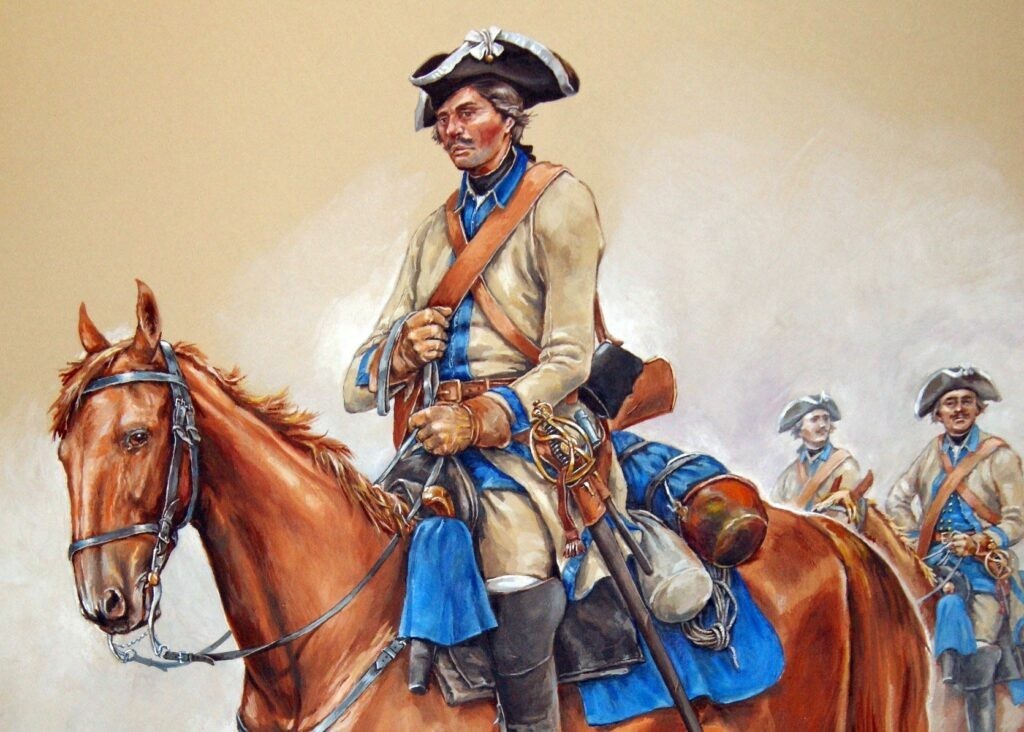
В основной своей массе, полки, вошедшие в состав Второй армии Петра Панина являлись полками так называемой Украинской линии, созданной еще Петром Первым для защиты южных рубежей страны от набегов татар и поляков. Как правило, эти полки являлись полками ландмилиции, так называемыми поселенными полками, привязанными к одной, определенной территории. Среди иррегулярных полков, также много подразделений приходились на ландмилицию, однако были и такие, которые создавались еще Богданом Хмельницким, в основной своей массе – малороссийские и компанейские. Часть полков составляли полки нового территориального образования-Новой Сербии, созданной переселенцами из Сербии, а именно Райко Прерадовичем и Иваном Шевичем, перебравшихся в Россию со значительным числом своих одноплеменников. Значительную часть войска составили донские казаки, в составе которых были также и калмыцкие подразделения.
The composition of the regular, i.e. The most trained part of the army included carabinieri, dragoon, infantry regiments with a separate grenadier regiment, as well as the Jaeger Corps. The regular army also included artillery, engineering and pontoon units. The irregular (non-permanent) army included regiments: hussars, pikemen, Little Russian regiments and, as mentioned above, regiments of Don Cossacks with Kalmyks assigned to the army.
A significant part of the regiments was part of the Ukrainian corps formed in 1763, and in 1766 almost all the regiments became part of the Ukrainian division specially formed for the war with the Turks, which was transferred to the jurisdiction of the governor-general of Little Russia - P.A. Rumyantsev. He, in turn, seeing the insufficient training of especially infantry regiments associated with their organization, structure and recruitment, already from 1769, leads them to the organization of army infantry regiments, with appropriate retraining and retraining.
Many of the regiments listed below did not survive by the beginning of the 19th century. Some of them were disbanded, some were reorganized, while others were sent to reinforce and replenish the newly created regular and irregular units of the Russian army.
Carabinieri regiments
January 17, 1763, six months after the beginning of the reign, Empress Catherine II reorganizes the cavalry. Six equestrian grenadier regiments: Riga, St. Petersburg, Narva, Ryazan, Kargopol and Astrakhan, as well as 13 dragoon regiments: Arkhangelsk, Nizhny Novgorod, Tver, Tobolsk, Novgorod, Rostov, Perm, Ingermanland, Siberian and others were named carabinieri.
The new carabinieri regiments were modeled after the French army. They consisted of 5 squadrons. Armament - carbine and broadsword. Carabinieri were first introduced into the army in Spain in the 15th century. During the described period, they were widely and very effectively used in all the armies of Europe.
The very term "carabiner" is derived from "carbine". This is a light weight firearm. It was used mainly for arming the cavalry. It differed from the infantry rifle with a shorter barrel length, and therefore less weight. The very same word "carbine" comes from the Arabic "carab", that is, "weapon".
The carabinieri acted in battles as follows. They lined up on the flanks of light horse troops, and in several lines, and at the beginning of the battle they jumped to the enemy. When there were 100-200 steps left to the enemy, a volley of firearms followed, as they said, in a row, after which the carabinieri retreated behind the cavalry.
On April 24, 1763, a statement was approved for weapons, ammunition and other things in the Carabinieri regiments.
According to the handicap, the caftan is set in blue, and the collar, lapels, cuffs and lining are in red; red camisole with sleeves; copper buttons; black tie, leather with white lining; pants - elk; a hat with a casket (tassel) with gold galloon and red tassels. Horse dress, like dragoons, but red.
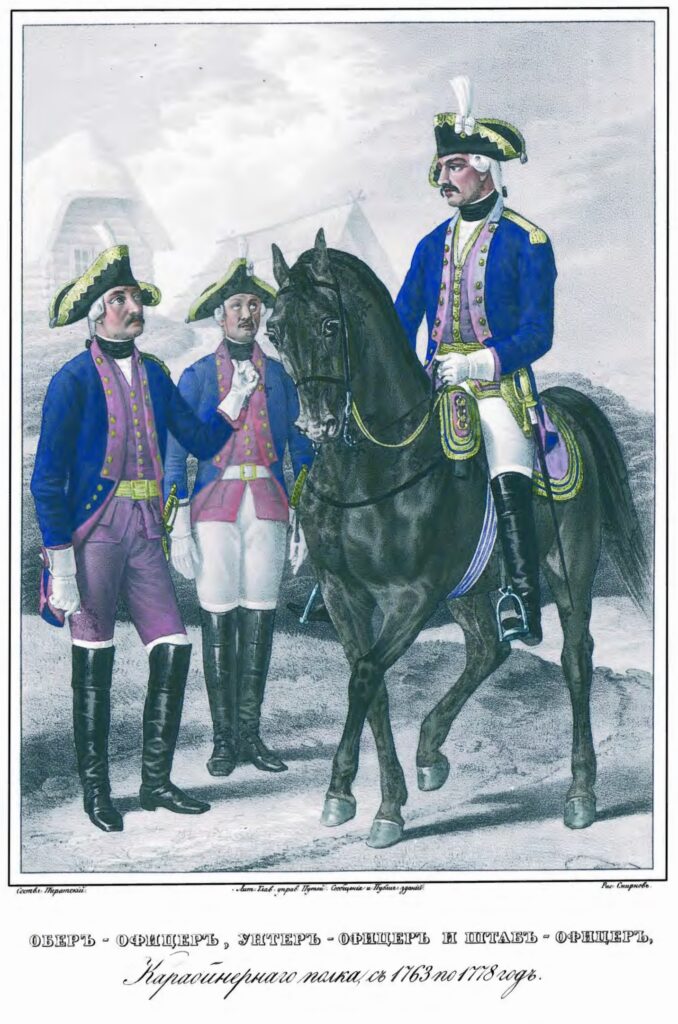
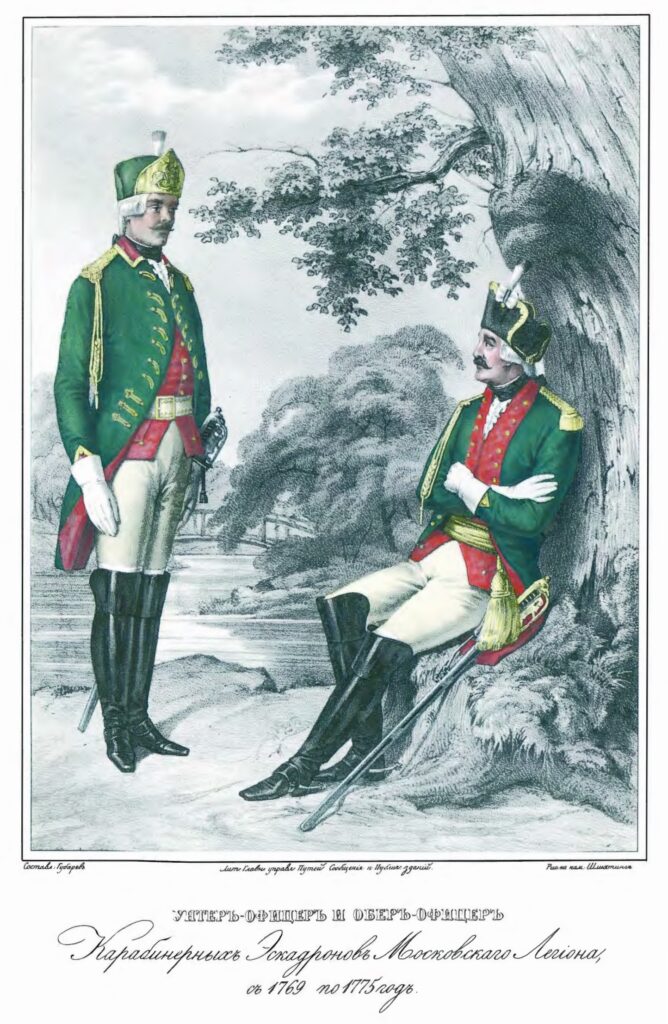
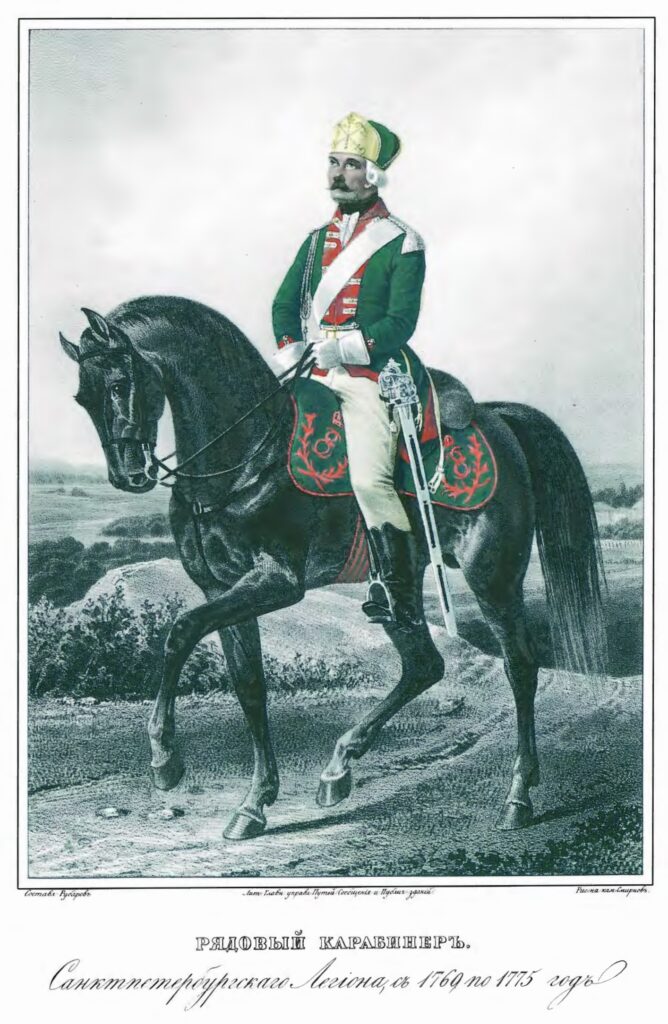
Rostov Carabinieri Regiment
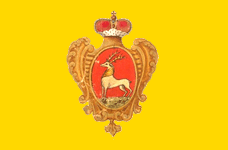
Сформирован в августе 1706 года как драгунский полковника Тихона Стрешнева полк в Москве боярином Стрешневым из разночинцев украинских городов, монастырских слуг и боярских людей. С 30 марта 1756 года полк был переформирован в составе двух гренадерских и 10 драгунских рот с приданием полку артиллерийской команды. До 1763 года полк был драгунским. С 14 января 1763 года назван Ростовским карабинерным полком. В 1766 году был введен в состав Украинской дивизии с постоянной дислокацией в городе Стародубове. Из литературы известно, что полк при штурме Бендерской крепости захватил одну из батарей противника. С 1796 года опять назван драгунским. В 1800 году был расформирован и направлен для усиления других драгунских полков.
Yamburg Carabinieri Regiment
It was formed in 1707 as the Ustyug Dragoon Regiment from recruits from townspeople. From November 1712 it was named the Yamburg Dragoon Regiment. On January 14, 1763, it was named the Yamburg Carabinieri Regiment, consisting of five squadrons of two companies each. In 1766, the regiment became part of the Ukrainian division, stationed in the city of Bubnov.
Pskov Carabinieri Regiment
В июле 1701 г. начальником Казанского и Астраханского приказов боярином князем Борисом Алексеевичем Голицыным сформирован в Москве в Золотой Палате из дворян, рейтар и их детей-недорослей – заоцких, подмосковных и низовых городов 10-ротный драгунский полк, названный по имени его первого командира драгунским полком полковника Федора Аристовича Новикова. 10 марта 1708 года полк получил название – Псковский драгунский полк. С 14 января 1763 года- Псковский карабинерный полк, приведен в состав пяти эскадронов.
In 1766, the regiment became part of the Ukrainian division, stationed in Poltava. In 1769, the commander of the regiment was the brigadier, Prince Ivan Bagration. Of the famous people, in 1778, the young cornet M.I. came to serve in the regiment. Barclay de Tolly.
Dragoon regiments
Darguns (from fr. Dragon, lit. dragon) - cavalry warriors trained to fight both on horseback and on foot.
For the first time this term arose in France in the 16th century, when during the siege of Piedmont, the French marshal Brisac mounted brave and dexterous infantrymen on horseback, who proved themselves very well in hostilities.
In Russia, dragoons belonged to the middle, linear cavalry. In different armies they were also called as mounted infantry or mounted riflemen. In Russia, for the first time, dragoon regiments were formed by Tsar Mikhail Fedorovich in 1631 from foreign mercenaries. In 1634, a second attempt was made to organize dragoon regiments, as a result of which three such regiments of 1000 people each were created. in each, but all the officers in it were only foreigners.
By the end of the reign of Alexei Mikhailovich, there were already 11,000 dragoons in the Russian army, armed with muskets, later carbines, pistols, swords, axes and short spears. Under Peter I in 1702, 12 dragoon regiments were created, and by the end of 1708, there were already 36 dragoon regiments and one dragoon squadron in Russia. Until the advent of the cuirassier in 1731, dragoons were the only kind of regular cavalry in Russia.
Already by 1763, the tactics of the battle began to change, when a bold and swift strike by lines of cavalry armed with cold weapons fades into the background, so the number of dragoon regiments was reduced to only seven. The revival of the dragoon regiments took place only before the Patriotic War of 1812.
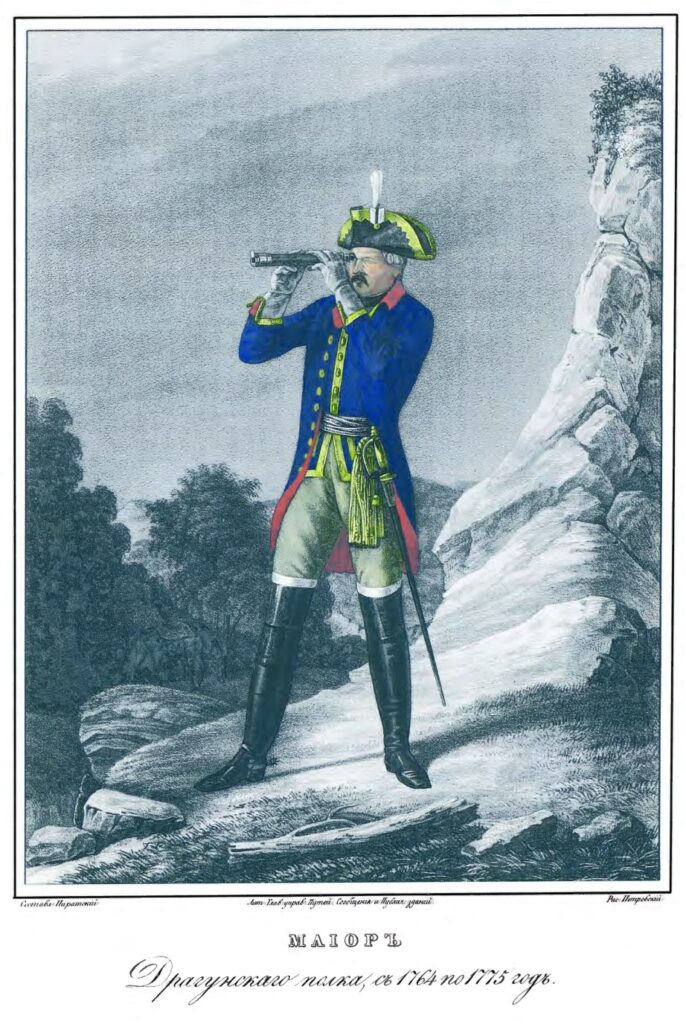
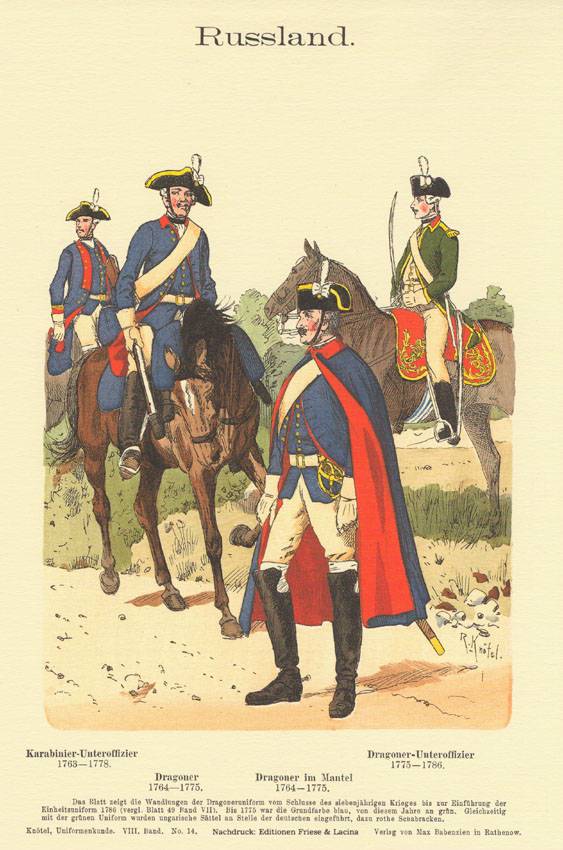
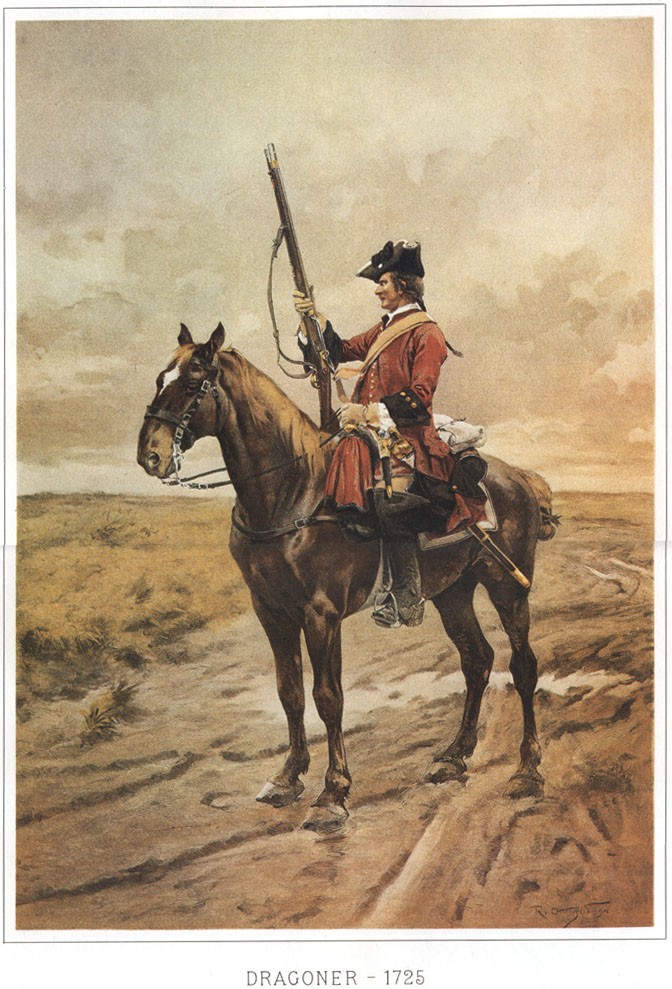
Borisoglebsky Dragoon Regiment
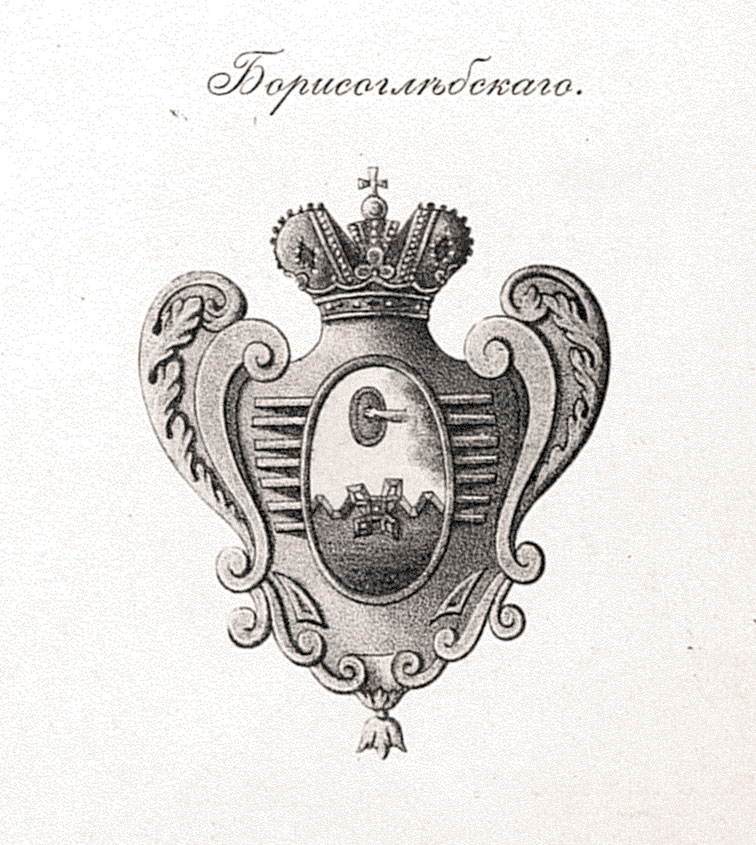
It was created on January 15, 1731 as the Borisoglebsk cavalry regiment of the Ukrainian Land Militia.[1] (поселенное войско) в г. Борисоглебск. 19 марта 1736 года полк был переформирован в конный. С 15 декабря 1763 года Борисоглебский драгунский ландмилицкий полк. Состав полка – штаб и две драгунские роты. К 1766 году вошел в состав Украинской дивизии, был расквартирован в Харькове. 16 января 1769 года назван Борисоглебским драгунским полком, передислоцирован в г. Переславль. Во время похода на Бендеры был приравнен к пехотным полкам. До Бендер, кроме охраны украинской линии в сражениях и боях не участвовал. В 1775 году присоединен к Астраханскому драгунскому для его усиления.
Astrakhan Dragoon Regiment
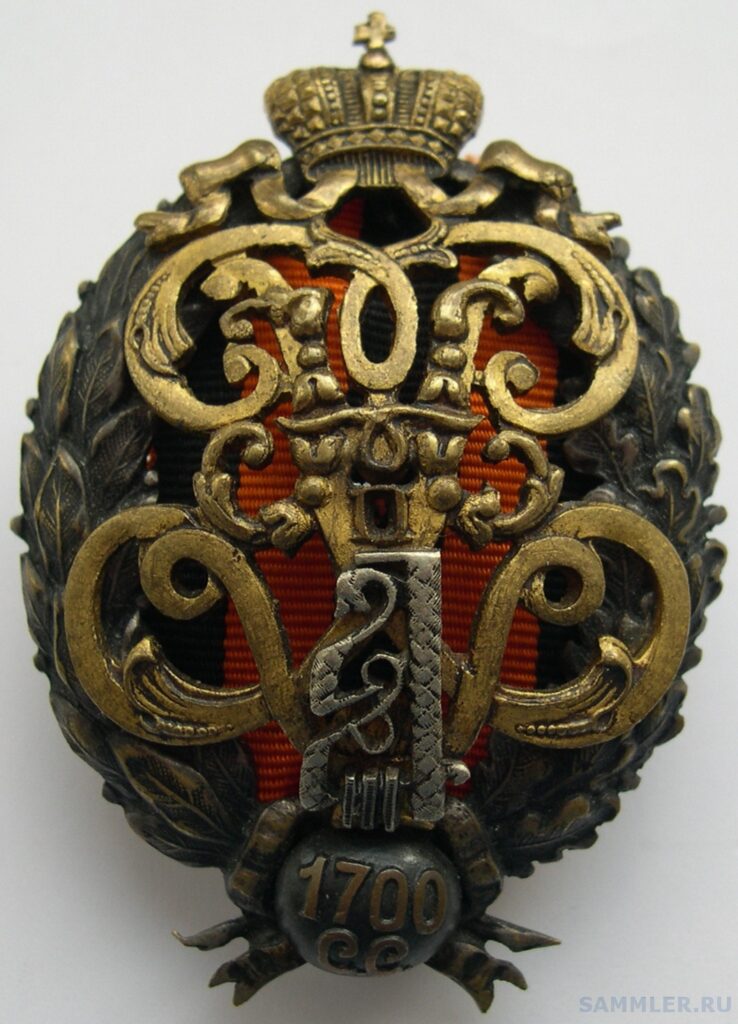
The regiment under this name is listed in the Second Army of P. Panin in the order for the troops, but it is very difficult to determine which particular regiment in question. According to service and viewing lists of the Russian army for the period from 1730 to 1796, the Russian army included eight regiments, called Astrakhan. Three dragoons, one of which is a garrison; 2 grenadiers, one of which is an equestrian grenadier; 1 carabinieri and 2 infantry. But, directly to the company 1769-1770. a regiment with that name is not listed in the army. At the same time, none of the Astrakhan regiments was part of the Ukrainian division. This, most likely, is about the Astrakhan Infantry Regiment, later the Astrakhan Grenadier Regiment, which was formed on June 25, 1700 by Prince Trubetskoy from 850 recruits in Novgorod as an infantry regiment of Roman Bruce, consisting of two battalions. Before the events described, he changed his name to the Vologda and 2nd St. Petersburg Infantry Regiment, but on July 5, 1762, his first name was returned to him. Since 1757 he was stationed in the city of Velikiye Luki.
С 1730 по 1770 год командиром полка был полковник Гудович И.В., из знаменитых людей, в 1783 году в полку начал службу рядовым князь П.И. Багратион. В период 1762-63 гг. шефом полка был Suvorov Alexander Vasilyevich, therefore, in some documents, the regiment is called Suvorov.
Infantry regiments
An infantry (rifle) regiment is the main combined-arms tactical unit in the ground forces in the armies of Russia and Europe.
The first such regiments were formed in the early 1630s as regiments of a new system of regular troops, each of which was a formation of a permanent composition of 8-12 companies and consisted of from 1600 to 2000 people.
Beginning in the second half of the 18th century, infantry regiments became widespread in the armies of most states. In Russia, the first 27 10-company infantry regiments were created under Peter the Great in 1699. At the beginning of the 18th century, the transition to a battalion structure was also made and infantry regiments were included in infantry brigades and infantry divisions.
As a rule, infantry regiments were part of infantry brigades or infantry divisions and fought as part of them. There were also separate infantry (rifle) regiments, which were directly part of the army and other associations.
During the time of Peter I, the structure of infantry formations looked like this:
- Streltsy regiments
- Elected and Guards regiments
- Soldier regiments formed before 1699
- Soldiers' talk, formed from 1699 to 1725
- Soldiers' training regiments
- Complete soldier regiments
As a rule, all regiments had two battalions; already under Elizabeth Petrovna, the number of regiments was increased; in 1747, a third battalion of 4 musketeer companies was added to the two existing ones. In 1753 the number of grenadier companies in the regiment increased to three; the battalion now included 1 grenadier and 4 musketeer companies. However, this composition did not last long: already after 3 years, the grenadier companies of the second battalions became part of the formed four numbered grenadier regiments. Each of them consisted of 10 companies, divided into two battalions. The high quality of these new regiments was already noted in 1757, even by a foreign observer who was not too disposed towards the Russians: “The main strength of their army consists in the granoder regiments, and indeed, all granoders are dense and strong people ...”.
By that time, all infantry regiments were mandatorily equipped with artillery. Each regiment was supposed to have 4 copper three-pound guns and 8 six-pound mortars. The gun fleet was completely transferred to the department of the regiment, and the servants were completed with the ranks of the regiment at the rate of 9 people per gun and 12 spares. An artillery officer enlisted in the staff of the regiment, who wore a regimental uniform, was in charge of this economy. Since 1757, cannons began to be replaced by quarter-card (twelve-pound) unicorns, but they were not enough. The army was supplied with eight-pound unicorns, as well as "secret" howitzers that fire buckshot. Every company in the state had a Fusilier trained in the arts of artillery fire.
Below, we will talk about the grenadier regiment, therefore, as mentioned above, it was the elite of the army. A grenadier is originally a kind of infantry designed to throw hand grenades (grenades), first appeared in Europe during the era of the 30 Years War 1618-1648. Only from 1667 did the grenadiers begin to exist as a special kind of troops, and receive their own organization. In Russia, grenadier units began to be created at the end of the 17th century. At first, special teams of grenadiers were introduced into the regiments, and already under Peter I, one company of this type of troops was introduced into each infantry regiment. In addition to the infantry, the grenadier began to be introduced already into the cavalry units. Their tasks, in addition to throwing grenades, expanded significantly, and they were considered the elite of the infantry and in battle rushed to the most dangerous areas to break through the enemy’s defenses or contain him. Peter also created five independent grenadier regiments, which were recruited exclusively from tall, courageous and proven soldiers and officers.
By the described “our” period in Russia, there were four Grenadier infantry regiments that did not have their own names. They were given names only in 1775. These are: 1st Life Guards Grenadier Infantry Regiment, 2nd Tauride, 3rd Ekaterinoslav and 4th Fanagoria.
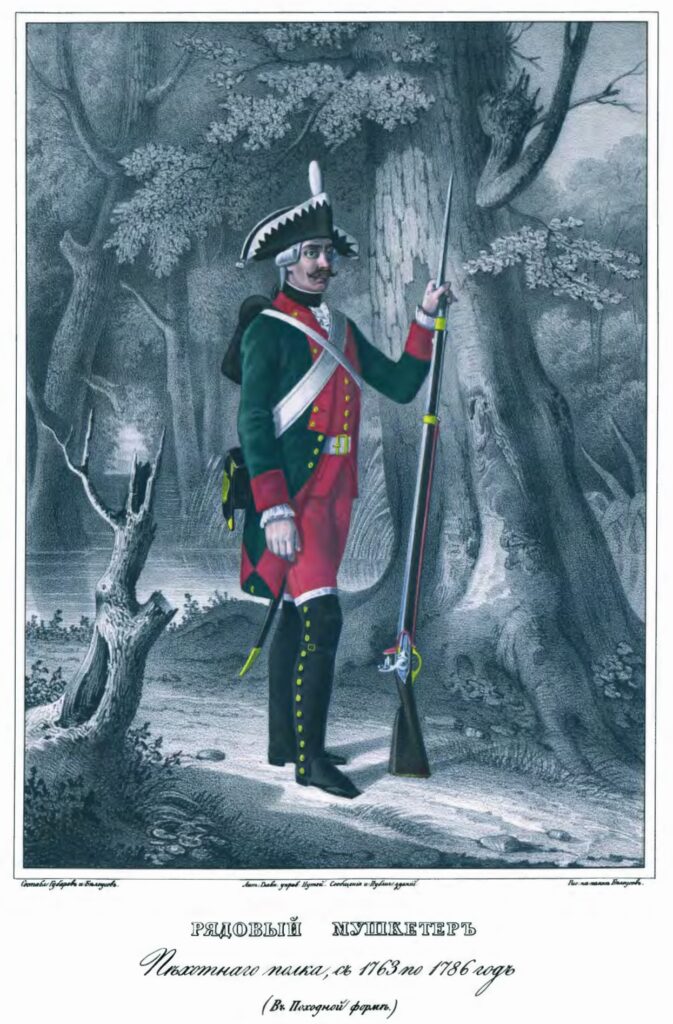
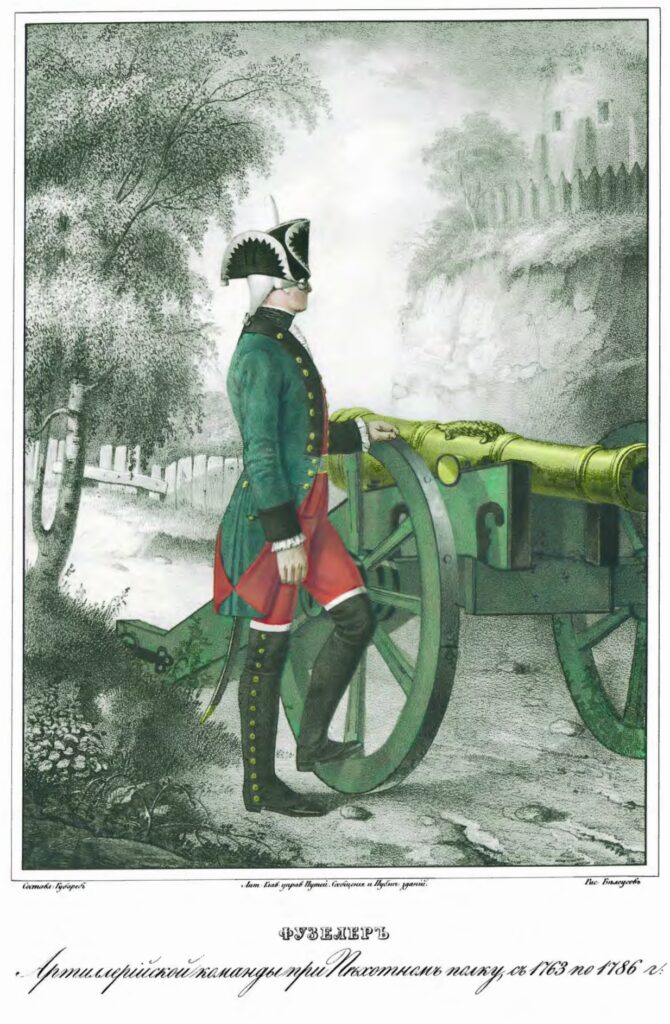
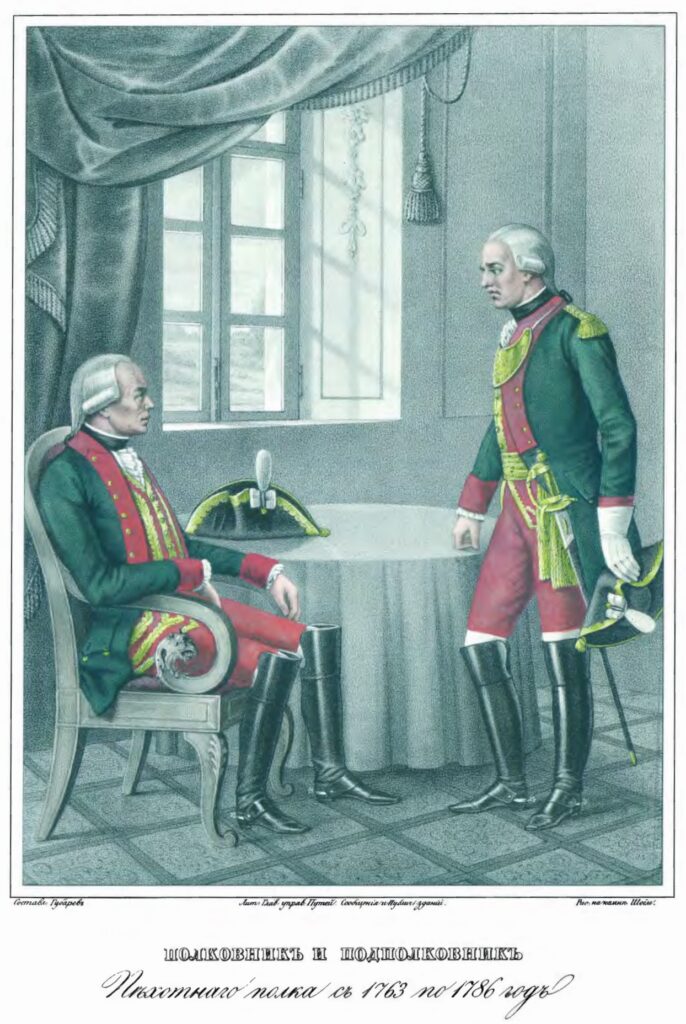
2nd Grenadier Infantry Regiment
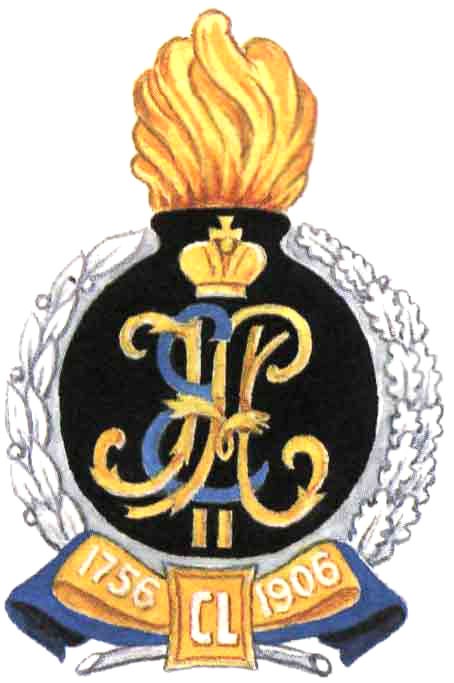
(later 2nd Tauride Grenadier and 6th Tauride Grenadier Regiment)
Один из четырех полков, сформированных 30 марта 1756 г. при восстановлении в России отдельных гренадерских частей. Сформирован из гренадерских рот, отчисленных от Санкт-Петербургского, Новгородского, Сибирского, Азовского, Воронежского и др. пехотных полков как 2-й гренадерский полк, в составе двух батальонов по 5 рот. Первоначально был расквартирован в Ревеле, а затем под Ригой. В Бендерах помимо общих задач, также охранял Главную квартиру армии.
Voronezh Infantry Regiment
The regiment was formed in Moscow by General Veide on June 25, 1700, consisting of 10 companies, under the name of the infantry regiment Fyodor Balk.
Вейде после смерти Ф. Лефорта в марте 1699 года принял в командование Лефортовским полком и был пожалован в бригадир-генералы. В 1703 г. при полку была сформирована гренадерская рота; 10 марта 1708 г. полк назван Воронежским пехотным полком.
С 16 февраля по 13 ноября 1727 г. полк носил название 5-го Московского пехотного полка. 28 октября 1731 г. гренадерская рота была упразднена и полк был приведён в состав 8 фузилерских рот, с 25 апреля по 5 июля 1762 г. он стал мушкетерским генерал-фельдмаршала принца фон Гольштейна полком. 14 января 1763 г. полк приведён в состав 2 батальонов с артиллерийской командой. Впоследствии полк, в связи с передачей своих батальонов для пополнения Азовского и Моршанского пехотных полков, перестал существовать под своим именем. Именно Моршанский полк ведет свое старшинство от Воронежского полка.
Chernihiv Infantry Regiment
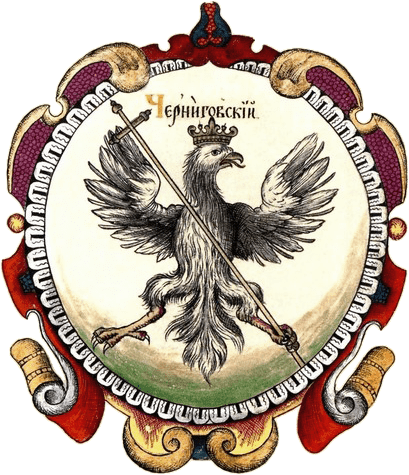
Также, как и Воронежский полк был сформирован генералом Вейде 25 июня 1700 года под именем пехотного фон Шведена полка в составе 10 рот. В 1705 году назывался пехотным Гассениуса, а с 10 марта 1708 года Черниговским пехотным полком. Также в своей истории носил имя Углицского пехотного полка. По комплектованию полностью повторяет Воронежский полк. В истории полк известен тем, что поддержал восстание декабристов в 1725 году, ведомый подполковниками Муравьевым-Апостоловым и Бестужевым. и в январе 1826 года был разгромлен правительственными войсками, вследствие чего был переформирован, более 800 человек полка были разжалованы в солдаты и сосланы на Кавказ.
Belevsky (Beletsky) Infantry Regiment
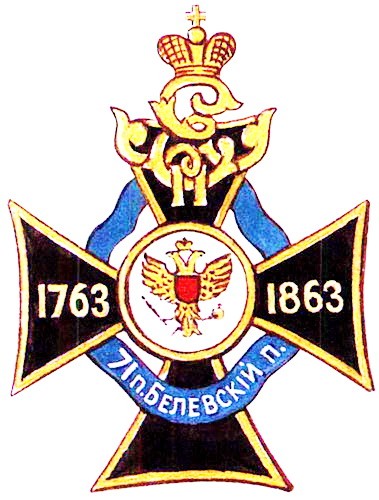
The regiment was formed as a result of the general reformation of the Russian army on December 15, 1763, consisting of two battalions, each of which had 1 grenadier and 5 musketeer companies, and was included in the Ukrainian landmilitsky corps. A regiment was formed from small landed nobles, later deprived of their noble rank and called one-palaces - one of the categories of state peasants, formed to carry out sentinel and guard service on the southern border, obliged to serve for 15 years. The final name of the regiment
received January 16, 1769. Since 1765, the regiment was commanded by Colonel Nikolai Glebov. The campaign against Bendery was the first baptism of fire for the regiment. From the journal of military operations and the history of the regiment, it is known that upon arrival in Bender, when the army was crossing the Bik River, he took part in repulsing the attack of the Turkish cavalry. Also, a special detachment was allocated from this regiment to strengthen the corps of General Kamensky for the siege of the fortress from the east, on the left side of the Dniester River.
Of the famous personalities on April 7, 1795, Brigadier Prince Dmitry Semenovich Lvov was appointed commander of the Belevsky regiment.
Bryansk Infantry Regiment
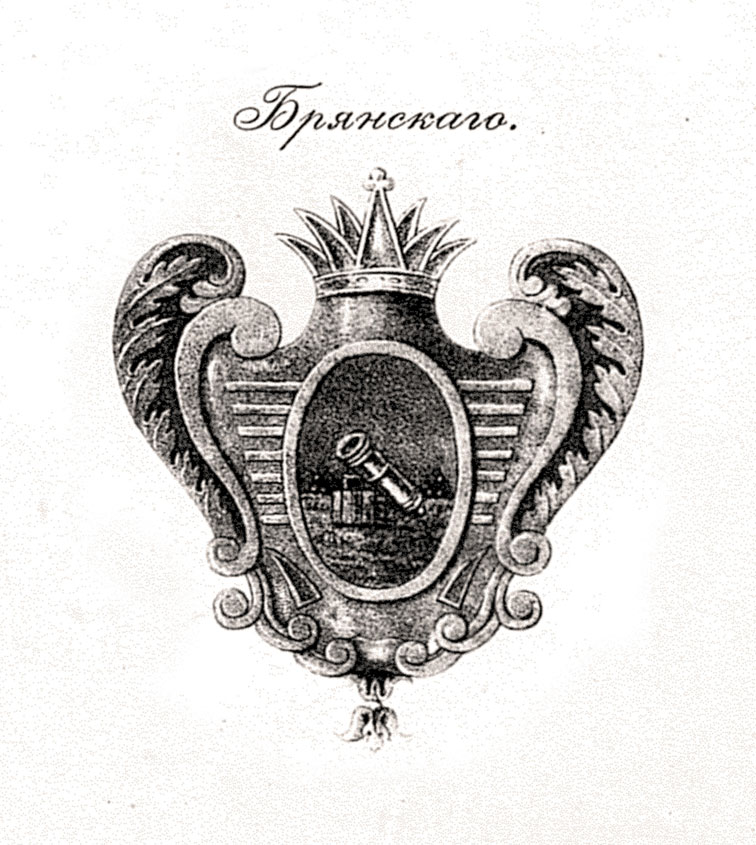
Как и многие вышеперечисленные полки этот полк был сформирован 4 апреля 1723 года как полк Украинской ландмилиции, под именем полковника Иваненкова полк. Свое постоянное название получил 16 февраля 1727 года, как и остальные пять подобных вновь сформированных полков, по месту своего расквартирования. Полк был конным и разделен на 10 рот. Числилось в нем по штату 1500 человек, но по спискам на 1732 год личный состав составлял 1053 единицы. Первоначально полк был сформирован из новобранцев, рекрутированных в большинстве своем из городов (местечек) Хотмыжск, Рыльск, Вольный и Мирополь. Впоследствии, временно система комплектования ландмилицких полков стала носить определенно-территориальный характер и в этом полку могли служить только выходцы из брянских земель.
The newly formed regiments, including the Bryansk Regiment, entered the Ukrainian division, transferred to the command of the general-in-chief, the governor-general of Little Russia, the president of the Little Russian collegium, the head of the Little Russian regiments and Zaporozhye Cossacks, Count P. A. Rumyantsev. By the same decree, the division was ordered to be completed, as before the Ukrainian corps, with South Russian odnodvortsy. Before the start of the Russian-Turkish war of 1768-1774, seeing the insufficient training of these regiments, Rumyantsev from 1769 began to transform them into infantry and dragoon regiments with appropriate training and education. After the capture of Bender, on November 8, 1770, all the regiments of the landmilitia were brought by state to the usual old army regiments.
It was this regiment that gave its ribbons from the banners to the newly formed Bryansk Infantry Regiment in 1806.
Yelets Infantry Regiment
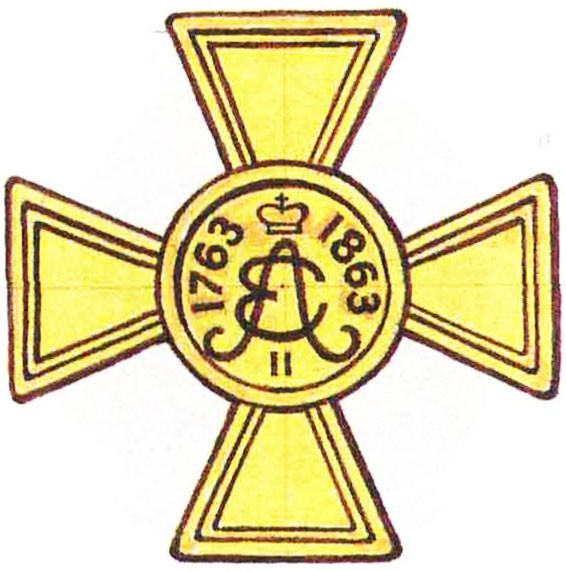
In fact, the regiment was formed on February 2, 1713, when Peter I established settled troops to protect the southern border of the state. Then the infantry regiments of Zhdanov, Grigorov, Vorontsov, Bulart and Postelnikov were formed with the addition of dragoons, soldiers, Cossacks and artillerymen to reinforce the garrison troops of the Kiev province, reorganized into 7 foot regiments (100 people each) and it was they who formed this settled army. On December 15, 1763, during the reorganization of the Ukrainian corps, consisting of 20 cavalry regiments, one Borisoglebsky cavalry and 10 foot regiments were created, one of which was Yelets. It was formed as part of two battalions, each of which had one grenadier and five musketeer companies. It is from this date that the regiment conducts its seniority.
It received its name on the basis of the Decree of the Senate of December 11, 1732, No. 6279, like other regiments of the Land Militia. January 16, 1769 the regiment was named Yelets Infantry. In the statement of the church of the regiment, preserved in the archive, there is such an entry: “ On January 16, 1769, the Yelets regiment was named infantry and at the beginning of the same 1769 participated in repelling the Crimean Tatars' raid on Little Russia, and then participated in the siege of the Bendery fortress and taking it by storm. On September 15/16, 1770, before the offensive, a prayer service was performed by the regimental priest. This information is taken from the description of the war with the Turks of 1769-1774. There is information in the sources that near Bendery in 1770, the grenadier companies of the regiment took part in the battles with the Turks, and during the assault, two companies of the regiment distinguished themselves in the assault column of Colonel Wasserman.
Kozlovsky Infantry Regiment
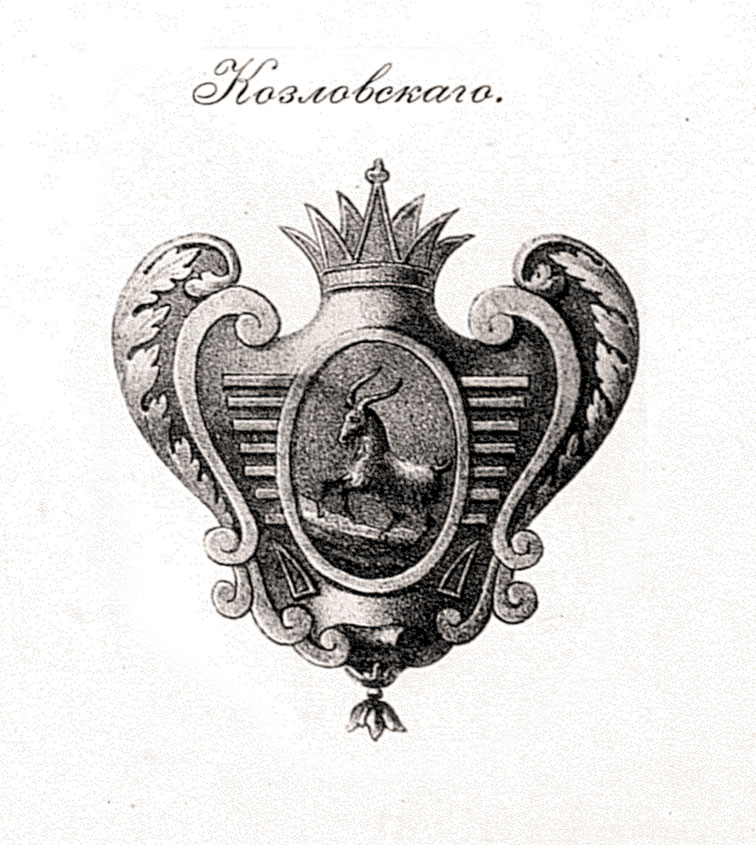
In 1657, as a result of the military-administrative reform, which assumed the creation and permanent existence of a large military unit of the Belgorod regiment, in Yablonov, near Belgorod, units were created from the settled regiments of Alexander Krafet, Yagan Krafet and John Leslie, created earlier in 1653. These regiments, as a militia, had already managed to take part in the war with Poland in 1654, at the end of which they were disbanded to their homes.
It was then, in 1657, that the 3rd Kozlovsky Soldiers' Regiment was created and was commanded by Colonel J. Ronort. It included mainly old soldiers recruited in 1653, as well as boyar children. The initial strength of the Kozlovsky regiment was 1575 people.
После стрелецкого бунта и его подавления многие старые полки были распущены. В 1711 году были учреждены в России постоянные гарнизоны, в которые входили оставшиеся от прежнего времени стрелецкие и рейтарские полки, а также гусары, копейщики и городовые казаки. Гарнизонные полки назывались по именам провинций и городов. В это время был образован Козловский гарнизонный полк, который вместе с Танбовским (Тамбовским) и другими полками (Короткоякский, Елецкий, Павловский) находились в составе гарнизона Осередской крепости (ныне г. Павловск Воронежской области). Позже полк был переименован в 3-й Симбирский, далее Белгородский гарнизонный полк получил название Козловский, а Симбирский стал Самарским. В 1732 году полк стал именоваться гарнизонный Козловский пехотный полк. 15 декабря 1763 года – составлявшие Украинскую Ландмилицию двадцать конных полков переформированы в одиннадцать пеших и один конный, в их число попал и Козловский.
The first battalion of the Kozlovsky regiment was settled at the fortress of St. Fyodor, the second - at the Kozlovsky fortress. In 1742, the regiment consisted of 1386 people, 87% of which were recruited from Kozlov.
Kursk Infantry Regiment
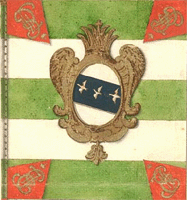
In fact, it was formed as a landmilitsky regiment in 1725 under the name of the Kigich regiment. Kursk got its name on November 6, 1727. On January 15, 1731, he became part of the Ukrainian Land Militia of the South of Russia. The history of the regiment is in many ways similar to the Landmilitia regiments listed above. The seniority of the regiment is indicated from October 1, 1763, when the Kursk Regiment of the Ukrainian Corps was officially formed. Subsequently, he gave his battalions to replenish the Smolensk and Yaroslavl regiments, it is the latter who leads his seniority from the Kursk regiment.
Oryol Infantry Regiment
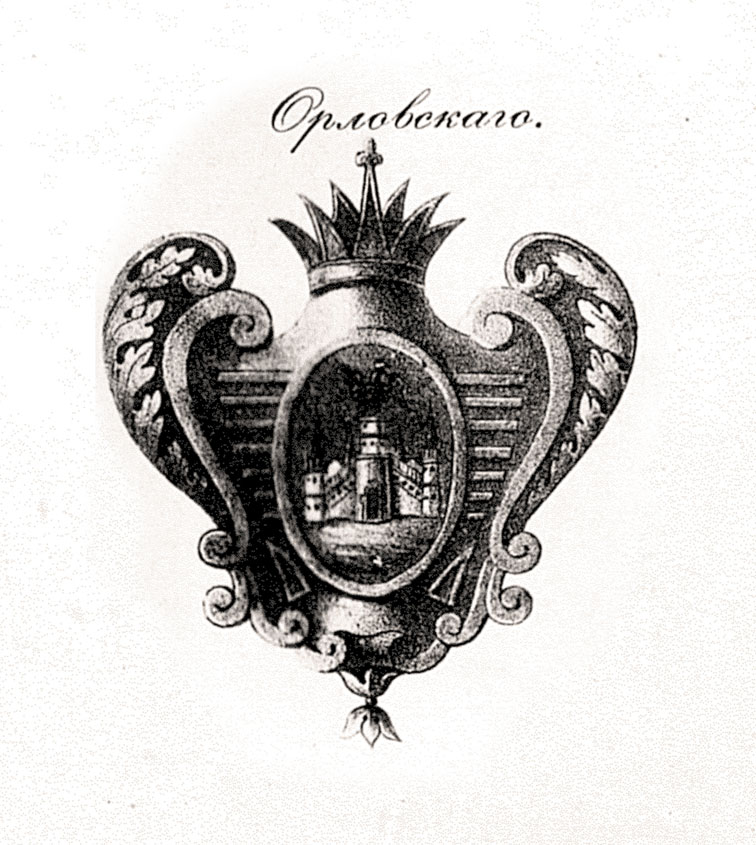
Первое воинское формирование в русской армии, носившее наименование «Орловского», было образовано в соответствии с Указом императора Петра II от 6 ноября 1727 г. Этот нормативный акт был предназначен для упорядочения дел в украинской ландмилиции — оригинальном элементе военной организации Российской империи, с перерывами существовавшем в 1713—1763 гг.
Согласно его положениям все имевшиеся на то время ландмилицкие полки стали именоваться не по именам сформировавших их командиров, а по названиям южнорусских городов или уездов. Так, конный полк Львова теперь получил наименование «Орловского конного полка». На 1732 год полк имел численность в 1046 чел. (2 батальона) и был сформирован, в основном, из рекрутов г. Воронеж и Старый Оскол. Первый батальон полка был заселен близ новой крепости Орловской, названной в честь полка, второй в крепости Св. Параскевы. По штатам, утвержденным в 1734 г.,
Орловский конный полк должен был иметь 1077 человек, в том числе 4 штаб- и 29 обер-офицеров, 70 унтер-офицеров и капралов, 880 нижних чинов и 31 музыканта. Старшинство полк ведет от 15 декабря 1763 года, когда он стал именоваться Орловским пехотным. Тогда уже Орловский пехотный полк состоял из двух батальонов по шесть рот в каждом. Одна из рот батальона была ударной — гренадерской, остальные — мушкетерскими. Из литературы известно, что гренадеры Орловского полка отличились при штурме турецкой крепости Бендеры 15—16 сентября 1770 г.
Ryazhsky Infantry Regiment
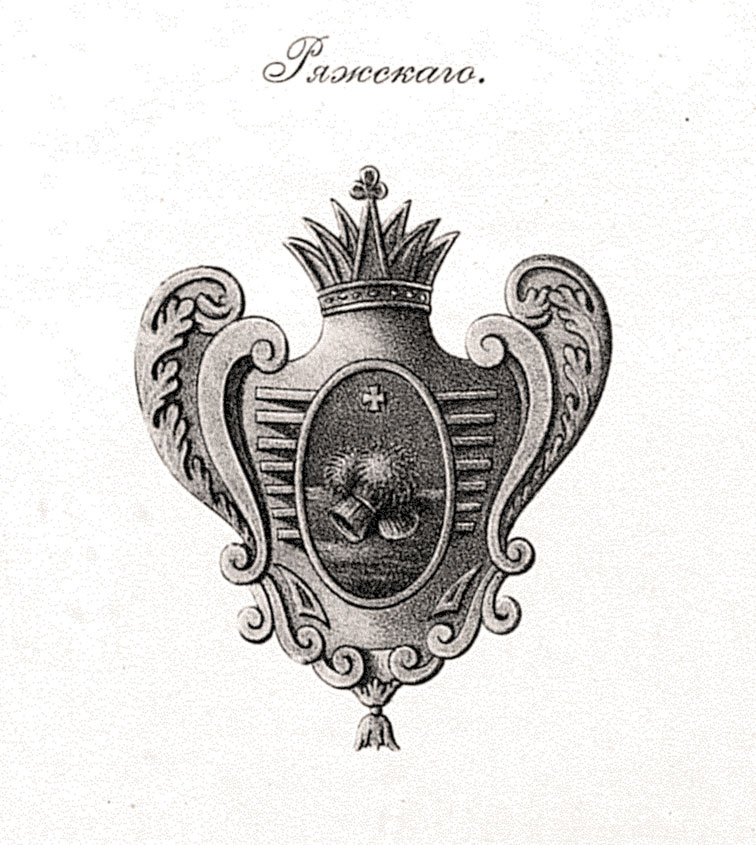
It was formed from odnodvortsev by decree of January 15, 1731, among 14 cavalry regiments of the Ukrainian Land Militia to protect the southern border. December 11, 1732 it was reorganized into foot. In 1733, the regiment had a strength of only 603 people. from the recruits of the city of Kozlov and Ryazhsk.
The first battalion was settled near the fortress of the same name, the second at the Vasilievskaya fortress.
On March 19, 1736, he was again mounted, part of the newly created Ukrainian landmilitsky corps, settled on the Ukrainian line. On December 15, 1763, the Ryazhsky regiment was reorganized into an unsettled foot regiment. From this day on, the seniority of the regiment is calculated as an infantry regiment of the regular army. The regiment consisted of 2 battalions, 10 fusilier companies and 1 artillery team. On January 16, 1769, the regiment became officially called an infantry regiment, the battalions began to consist of 1 grenadier and 5 musketeer companies.
The regiment from 1766 was part of the 8th Ukrainian division. The city of Lubny was determined as the place of his permanent registration. The commander of the regiment from 1764 to 1770 was Colonel (since 1768 foreman) Bogdan Ivanovich Wasserman, who received the rank of major general in 1770 "for Bendery" and one of the 1st who became a Knight of the Order of St. George 4th class.
The regiment subsequently gave its seniority to the newly formed 70th Ryazhsky Infantry Regiment.
Sevsky Infantry Regiment
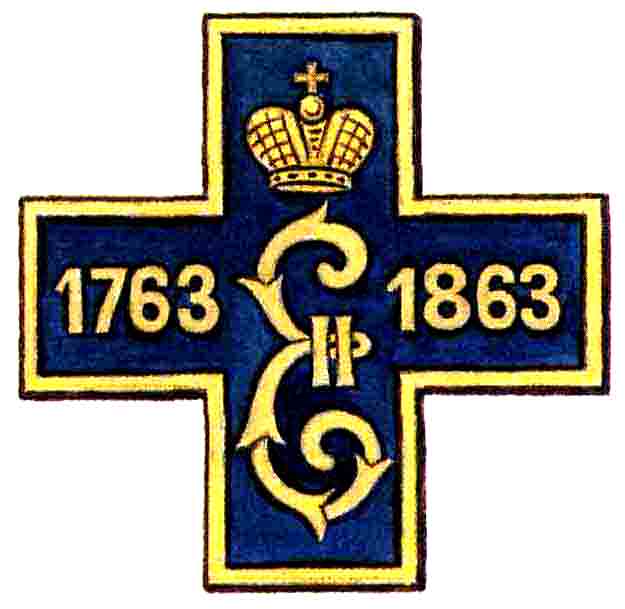
To the report submitted in 1732 by General Count Weisbach to the Military Collegium on the renaming of 20 landmilitsky regiments, a register of regiments was attached, which were supposed to have the names of Ukrainian cities. This register also mentioned the landmilitsky cavalry regiment, located in the city of Sevsk. In 1732, the personnel of the regiment was 1001 people, recruited from the recruits of the cities of Livna and Orel. It was formed simultaneously with Rylsky, Kursk and Belgorod. In 1775, the staff of the regiment was already 1229 people from the recruits of the cities of Kursk and Oboyan. Completely repeats the history of the above infantry regiments. He also leads his seniority from December 15, 1763, when the Sevsky regiment was formed among the foot regiments of the Ukrainian Corps, consisting of 2 battalions, each with 1 grenadier and 5 musketeer companies.
01/16/1769 - Sevsky Infantry Regiment.
He gave his seniority to the 34th Infantry Sevsky Count Kamensky Regiment. It is known from sources that in 1770 the commander of the regiment was Colonel David Magabeli.
Stary Oskol Infantry Regiment
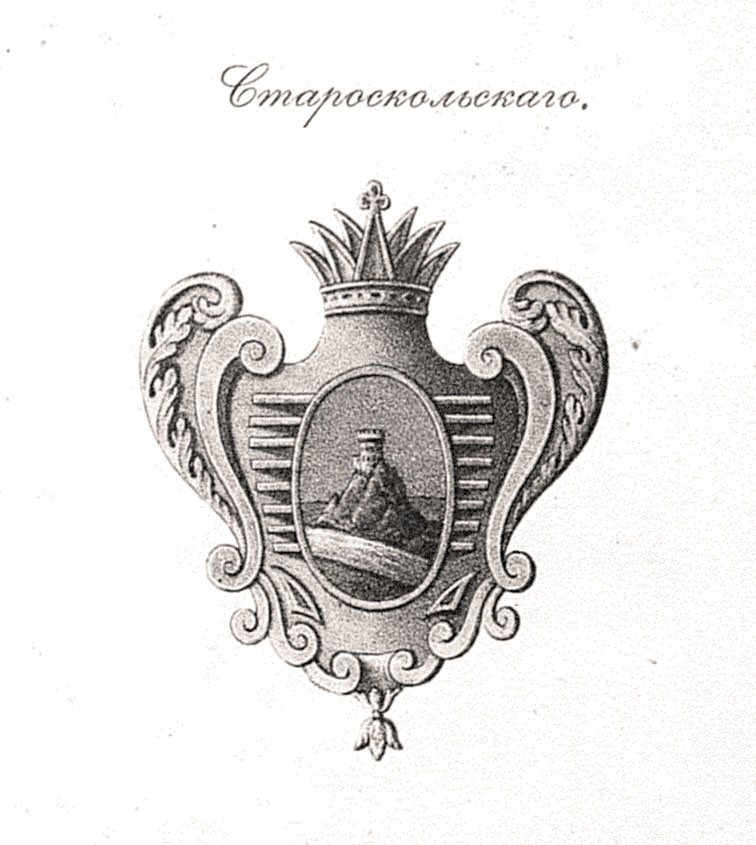
Сформирован как конный ландмилицкий 15 января 1731 года. Упоминается одновременно с Брянским и Ливенским полком. Как и вышеперечисленные полки имел два батальона. Тогда же был сформирован и Новоосколький полк, поселенный в Новом Осколе. Как и вышеперечисленные полки 15 января 1763 г. превращён в пеший, а в 1770 г. приписан к полевым полкам. На 1770 год командиром полка был полковник Павлов. Полк дал свое старшинство 114-му Новоторжскому пехотному полку.
Tambov Infantry Regiment
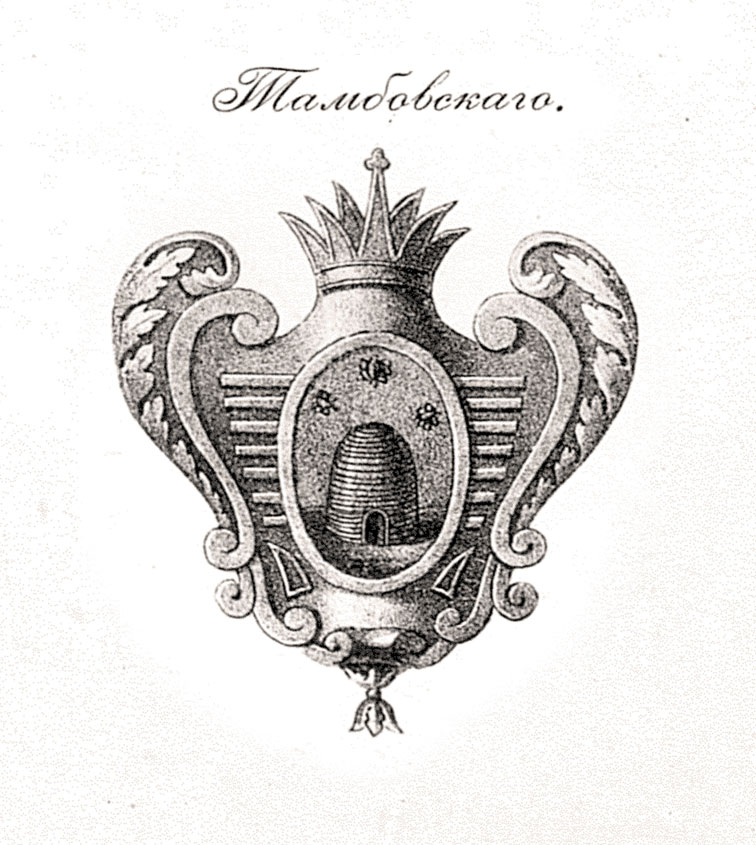
Формировался также как конный ландмилицкий 15 января 1731 года, упоминается вместе с Козловским и Ефремовским полками. Известно, что 1775 год в полку было всего 222 человека из рекрутов города Тамбова. Один из батальонов был поселен при крепости Тамбовской на реке Бузовой (ныне Харьковская обл.), другой при крепости Св. Петра. Также, как и вышеперечисленные полки в 1763 году превращен в пеший, а в 1770 году приписан к полевым полкам.
In 1770, the commander of the regiment was Colonel Matthias Miller, commander of the central assault column, which moved into the breach on the Bendery fortress and who died one of the first to climb the ramparts of the fortress. From the battalions of the regiment, the 27th and 28th Jaeger regiments were subsequently formed.
Jaeger Corps
The word "huntsman" comes from the German word Jager, which means a shooter, a hunter, a specialist in hunting, serving amateur hunters and monitoring compliance with the rules of hunting. The military meaning of the word huntsman refers to a light infantry or cavalry warrior in the armies of most European states. Jaegers as a type of special forces appeared in European armies in the 17th - 19th centuries. As combat-ready military units, the huntsmen proved themselves as early as the 30-year war of 1618-1648. Such detachments were formed from former hunters and good shooters.
In the Russian army, the first experimental battalion of rangers was formed by Field Marshal Count Pyotr Rumyantsev in 1761. And at the beginning of 1763, regular light infantry, called rangers, appeared in the Russian army. For the first time such units were created in the Finnish division, commanded by Count Panin. It was a contingent formed from selected shooters in the amount of 300 people - 5 people per company. This experience was crowned with success, and already in 1765, with 25 infantry regiments (about half of their total number), separate jaeger teams were established, consisting of one officer and 65 chasseurs. In 1769, such jaeger teams were introduced in all infantry regiments, and a year later jaeger teams began to be reduced to battalions, and then to corps. The latter constituted special chasseur regiments.
The purpose of the rangers was to serve as "skirmishers", i.e. leading search engines, who should have been able to fight in a loose battle. At the same time, they had to “produce fire”, but not according to the Prussian model at 30 paces, but according to their own “manual skill” with a maximum charge rate and integrity of the butt, which meant the ability to carry out the so-called. "selective targeting", i.e. conduct sniper fire "on priority targets of destruction."
The huntsmen were dressed in a special uniform - a dark green dolman with cords, dark green tight-fitting trousers, as well as a small huntsman cap and knee-high boots.
In the army of Pyotr Panin in 1770, in Bendery, all rangers were separated into a separate corps, which was used both independently and in cooperation with other regiments and divisions.
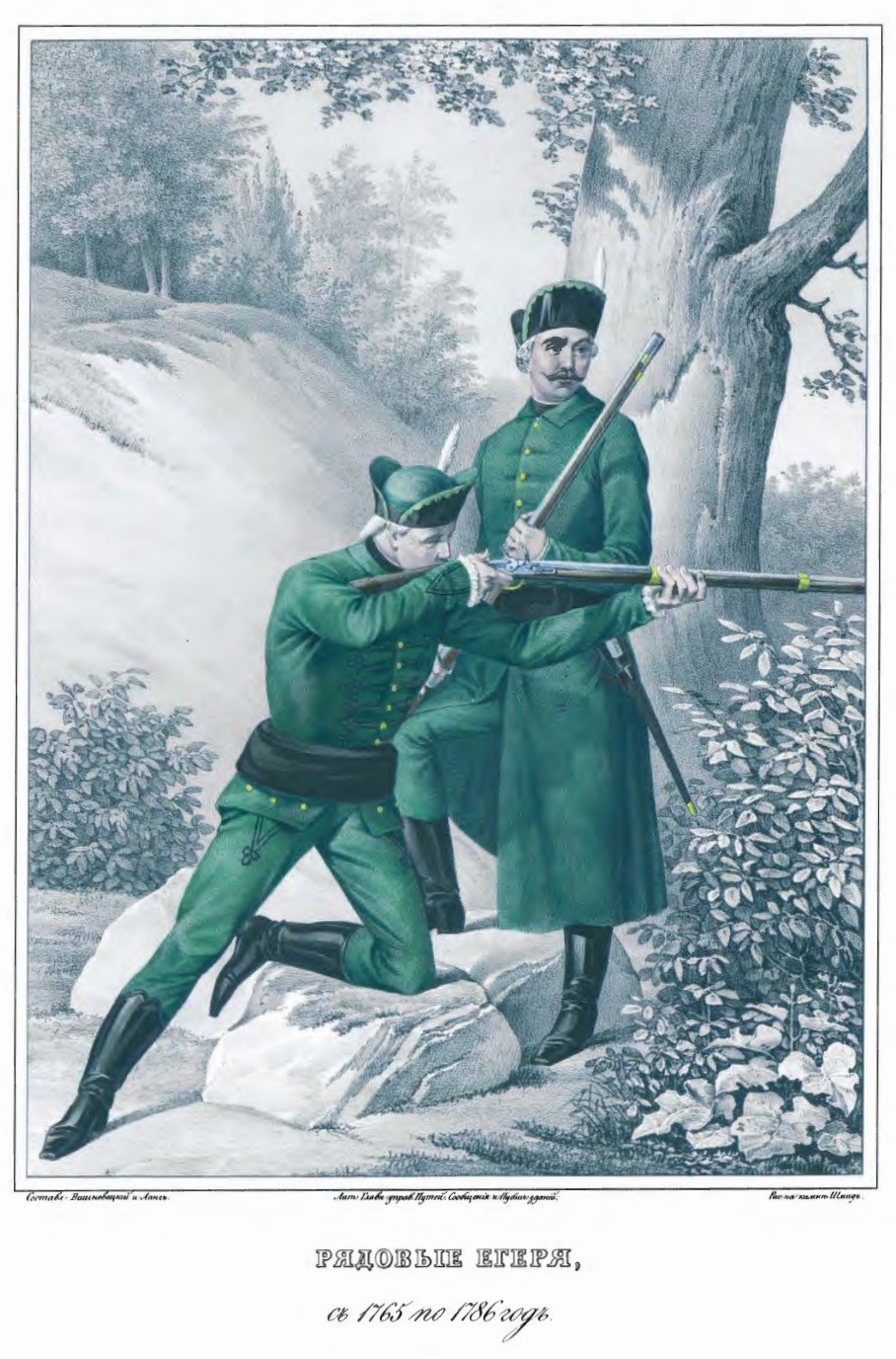
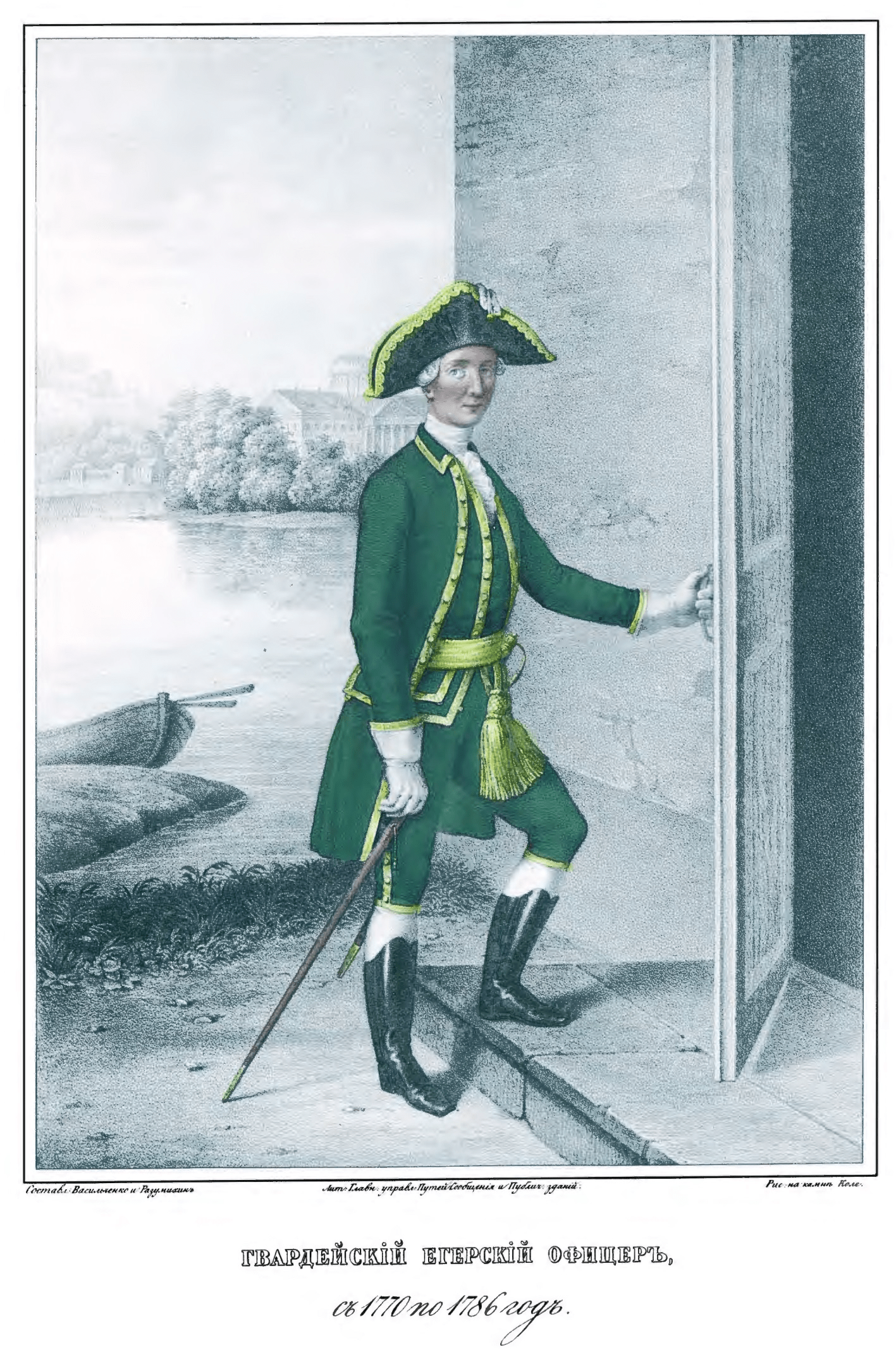
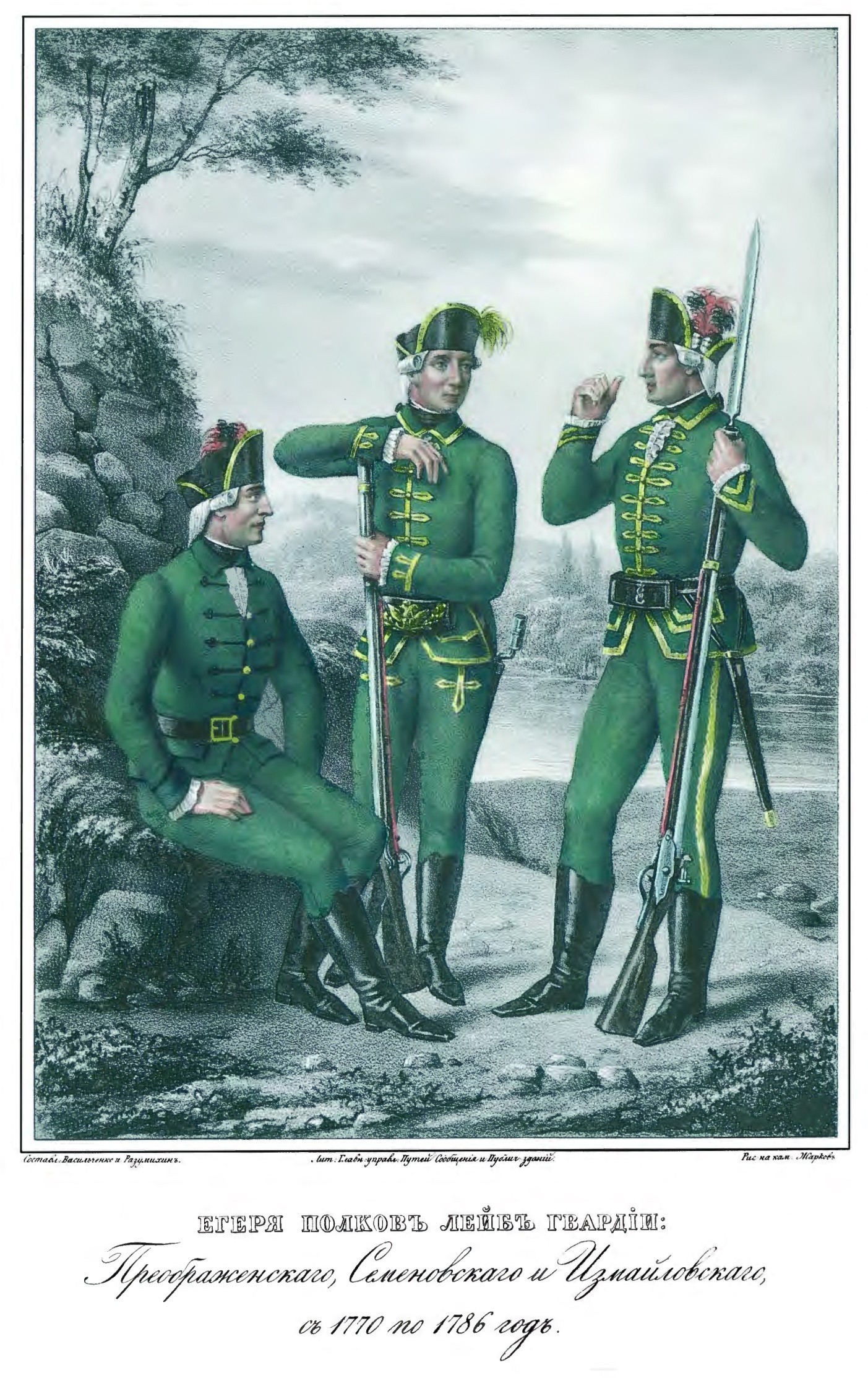
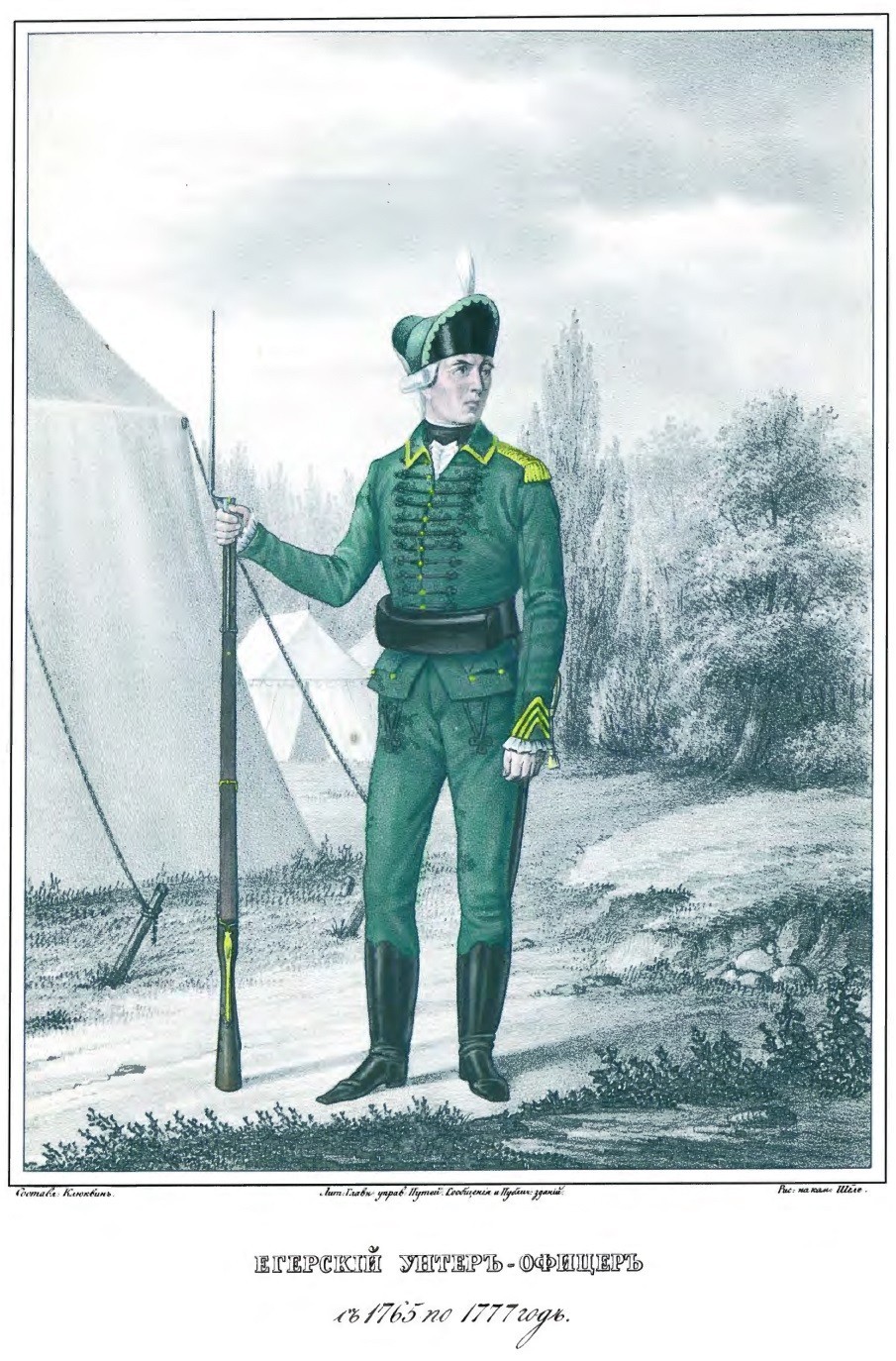

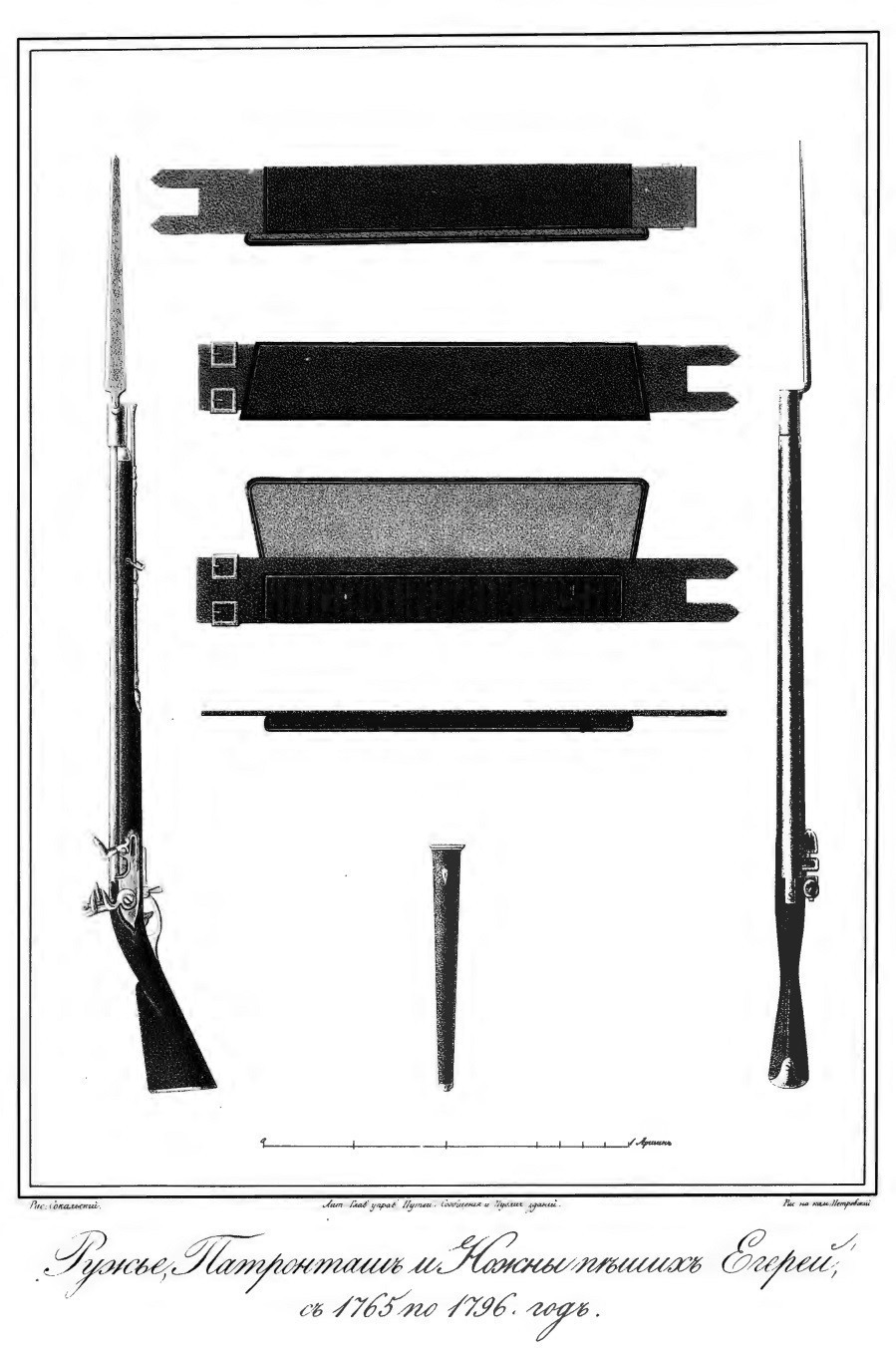
Irregular troops in the Russian army
Irregulars (from Late Latin irregularis - incorrect), unlike regular troops - troops that do not have a firm and permanent organization or, in terms of their recruitment, military service, training, education, uniforms, are significantly different from regular troops, uniformed themselves, equipped, armed and provided horses. Earlier in Russia, the troops consisted of Cossacks and foreign units.
Irregular formations, as highly maneuverable, but poorly armed and insufficiently trained to operate in the ranks, were attached to units and formations of the regular Russian army to carry out specific activities for this type of light cavalry, reconnaissance and surveillance, patrols, outposts, ambushes, raids and raids on the rear and pursuit broken running enemy.
When creating such troops, in the first place, it was assumed that these would be Cossack troops. It was in the army of Peter Panin that the regiments of the Don Cossack army were represented, as well as hussars, pikemen, Little Russian Cossacks and other regiments.
Hussars
Hussars (Hungarian huszár) are lightly armed horsemen of the 15th-20th centuries (along with lancers), distinguished by their characteristic clothing: shako (high cylindrical hat with a visor), mentic (fur cape), dolman (short uniform), leggings, boots. In the XV-XVII centuries, they wore light armor, including incomplete armor. In Russia, hussars are first mentioned in 1634, and also in 1660 (the hussar company of Ivan Khovansky). Under Peter I, hussars were recruited from Volosh, Serbian and other South Slavic immigrants living in southern Russia. Under Anna Leopoldovna, Minikh transformed all hussar units into 5 settled hussar regiments (Serbian, Georgian, Moldavian, Wallachian and Hungarian).
In 1754, Serbs Raiko Preradovich and Ivan Shevic entered the Russian service with a significant number of their fellow tribesmen; they were instructed to settle between Bakhmut and Lugansk (Slavic-Serbia) and form 2 hussar regiments of 1 thousand people each, which in 1764 were united into one - the Bakhmut hussar regiment. In 1756, the Sloboda Hussars and the Macedonian Regiment were formed from the Cossacks, Macedonians and Bulgarians. In 1760, the Yellow (Golden) Hussars Regiment was formed. In total, by 1761 there were 12 hussar regiments in Russia.
При Екатерине II после различных преобразований гусарские полки были переименованы в легкоконные.
Sumy Hussar Regiment
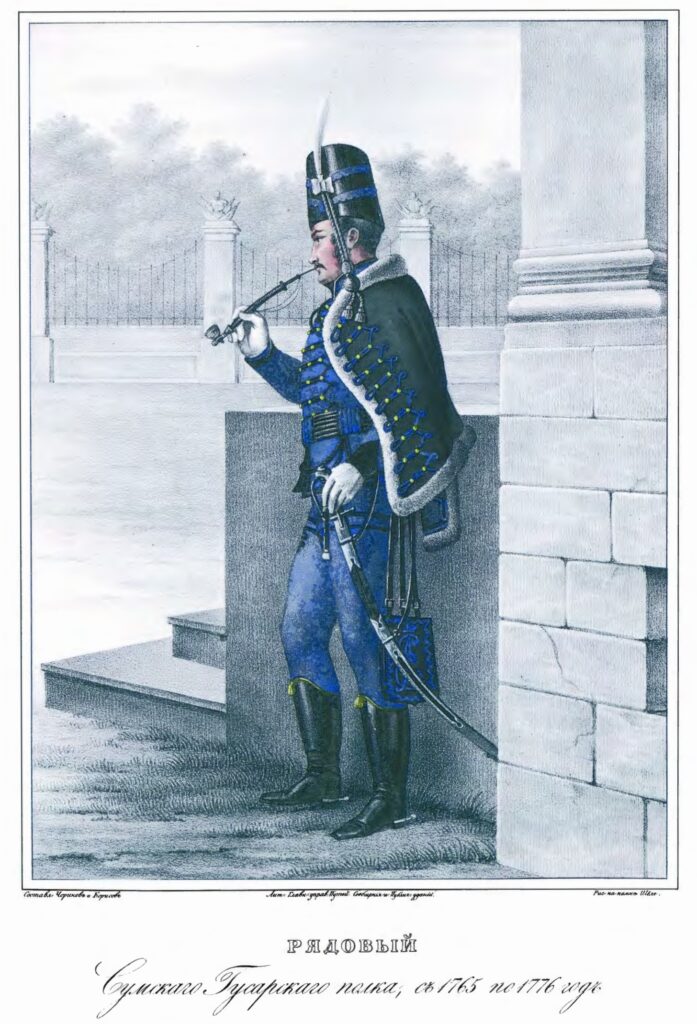
On June 27, 1651, the Sumy Sloboda Cherkassy Cossack Regiment was formed from the "Cherkas" who made up the population of the Sloboda-Ukrainian region and originated from Little Russian immigrants who fled from Polish oppression. In 1731, a regular company of 100 people was established under the regiment. 03/03/1765 - ordered the governor of the Sloboda-Ukrainian province, Prime Major of the Life Guards of the Izmailovsky regiment Shcherbinin in Sumy, to reorganize the regiment with the addition of ranks from the Black, Moldavian, Serbian and Georgian hussar regiments to the Sumy hussar regiment.
Из литературы известно, что в 1769 году, принимая участие в первой русско-турецкой войне, сумские гусары под командованием полковника Т.И. Тутолмина отличились в бою под Бендерами, где, потеряв только 20 человек, уничтожили большое количество турок и захватили 4 тысячи пленных и 600 лошадей.
In 1770, the entire Russian army learned about the regiment. A detachment of Sumy hussars under the command of Second Major Dedevshin was surrounded by 10 thousand Tatars, but literally cut through their system, losing 177 people killed and 26 wounded. Having destroyed a large number of askers, including seven murzas, the hussars captured the enemy banner. This case, however, was far from the only feat. At the end of the war in 1773, the commander of the army, Count P.I. Panin, personally introduced the Sumy Hussar Regiment to Empress Catherine II. It was then that the affectionately respectful nickname "Sums daring" was assigned to the Sumy hussars. Subsequently, Ya.P. served in the fourth squadron of the regiment. Kulnev.
Izyum Hussar Regiment
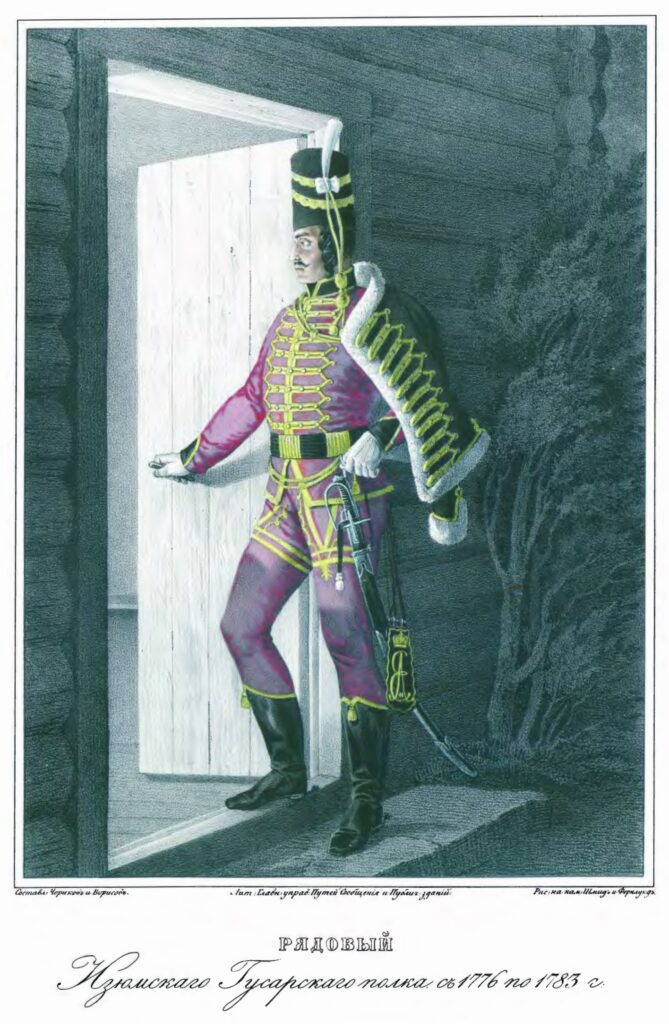
On June 27, 1651, the Izyum Sloboda Cossack Regiment was formed from immigrants from Little Russia, who settled in settlements on the right bank of the Northern Donets and along the banks of the Izyumets River. The main purpose of the Sloboda regiments was to protect the southern borders of Russia. At the same time, the Slobozhans ran a household and lived in families. Since 1651, the seniority of the regiment has been going on.
Soon it began to be called Kharkov Sloboda, and since 1688 it regained its name again (Colonel Konstantin Donets-Zakharzhevsky). In 1662 and 1666, the Sloboda regiments repulsed the raids of the Crimean Tatars, and in 1668, Tsar Alexei Mikhailovich awarded letters of commendation for loyalty and courage. In 1695 and 1698, the Izyumians recaptured a number of Tatar fortresses on the Danube and operated near Perekop. In 1733, the regular strength of the regiment was 800 Cossacks. In 1765, a new stage in the life of the regiment began, on March 3 it was renamed the Hussar (Colonel Zorich), with a staff of six squadrons in the amount of 1034 people (based on the approved report of the Military Commission “On the establishment of five field Hussar regiments from the Sloboda regiments, on recruiting and their content). In 1768, Field Marshal Count Rumyantsev recognized the Izyum regiment as the best in Little Russia. In 1770, the commander of the regiment was Lieutenant Colonel Akim Bedryaga.
Black and Yellow (Gold) Hussars
24 декабря 1751 г. и 11 января 1752 года, полковником австрийской армии Хорватом были образованы два гусарских полка, названных Пандурскими (от местечка Пандур в Венгрии). Все полки состояли из 20 рот. Для поселения им назначили земли между речками Амельники и Каварлык (притоки Днепра), которые повелено называть Новой Сербией. В 1764 году два пандурских полка, вместе с Новомиргородским гарнизоном и сербскими гусарами, переформировываются в три поселённых конных полка: Чёрный и Жёлтый гусарские и Екатеринославский пикинерный. Желтый гусарский полк впоследствии был расформирован 24 декабря 1776 года, как и Черный гусарский полк, известный еще и как полк генерала Мегульнова.
Bakhmutsky (Bakhmuchesky) hussar regiment
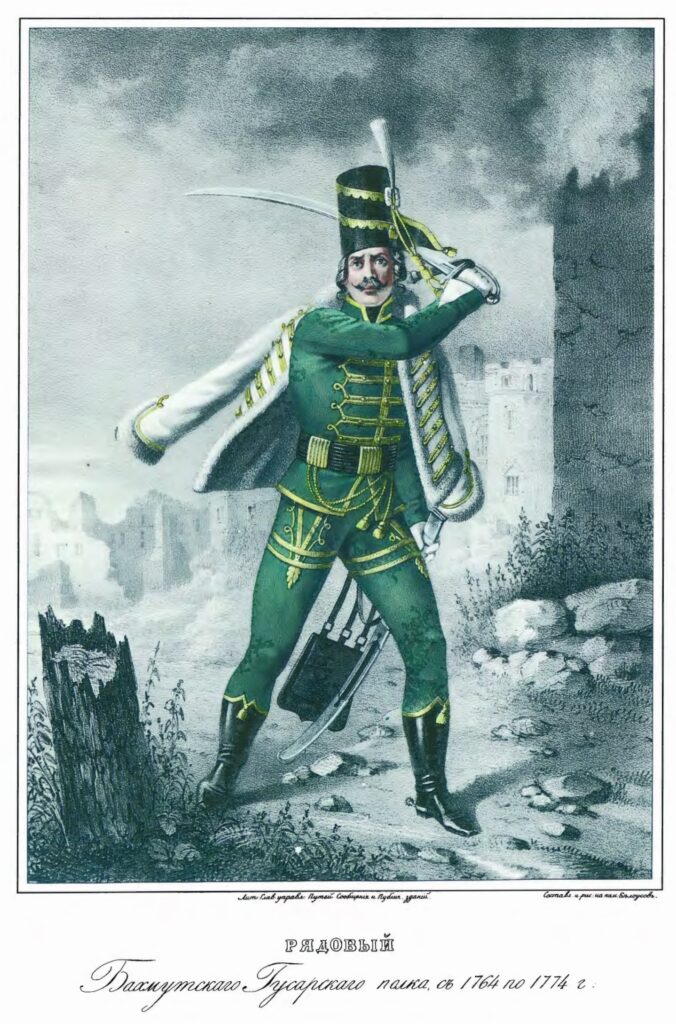
Как уже было сказано выше, в 1754 году сербами Райко Прерадовичем и Иваном Шевичем были образовано 2 гусарских полка по 1 тысяче человек в каждом, которые в 1764 году были объединены в один — Бахмутский гусарский полк. Рот (поселений) в полку было 16. Местность, заселённая поселёнными полками Прерадовича и Шевича, получила название Славяносербия. Она не входила в состав губернии, а непосредственно подчинялась Военной коллегии. Для организации поселения, комплектования и содержания поселённых гусарских полков Военной коллегией в 1753 году была учреждена Славяносербская комиссия. Она располагалась в городе Бахмут, который не входил в состав Славяносербии. Существовала также должность начальника Славяносербии, которую в начале занимал Райко Депрерадович, а затем Иван Шевич. Полк, как и Желтый с Черным полком был расформирован в 1776 году, в связи с ликвидацией Запорожской Сечи и созданием новых поселенных полков.
Pike regiments
Pikemen - a type of infantry in the European armies of the XIV - early XVIII centuries, armed mainly with 5-6 meter peaks. The well-coordinated formation of pikemen represented a formidable force in defense, but was distinguished by low mobility when attacking. Similar types of troops appeared in Scotland as early as the 13th century. Pikemen operated mainly in detachments, lines or groups. They were effective in defense against melee units, cavalry and represented a formidable force for them. In Russia, they were originally called spearmen. In the process of evolution of this kind of troops, spearmen were transferred to horses, and they became light cavalry.
The pike regiments were light cavalry regiments of the Russian army, which existed from 1764 to 1783 on the territory of the Novorossiysk province and were engaged in protecting its borders from the attack of the Turks, Perekop and Crimean Tatars; also irregular military-settlement regiments in the Ukrainian Cossack army. In addition to pikes, they were also armed with carbines and sabers.
Образованы после ликвидации полкового устройства на Украине из охочих служивых людей, части казаков Миргородского и Полтавского полков, а также военных поселенцев Новой Сербии и Славяно-Сербии. Самыми первыми пикинерными полками, созданными в 1764 году, были Луганский и Полтавский.
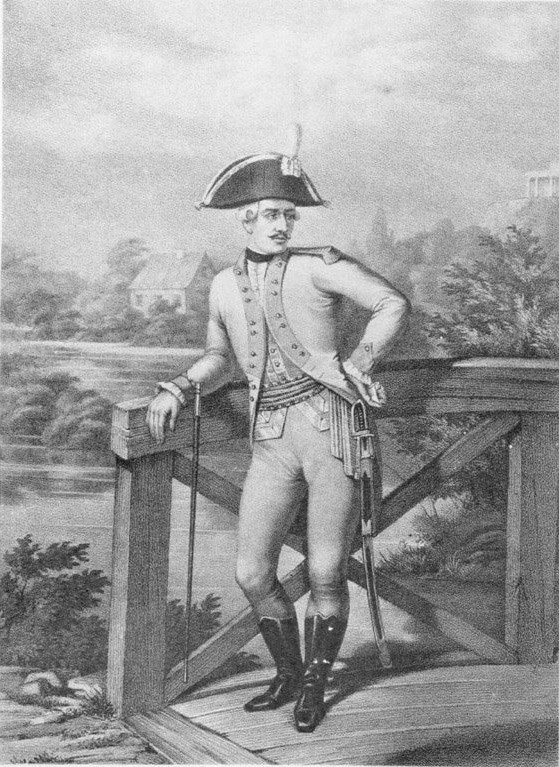
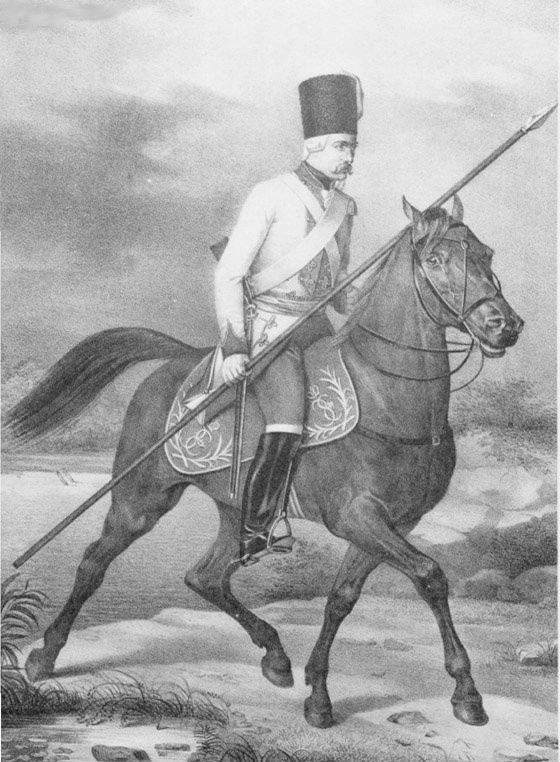
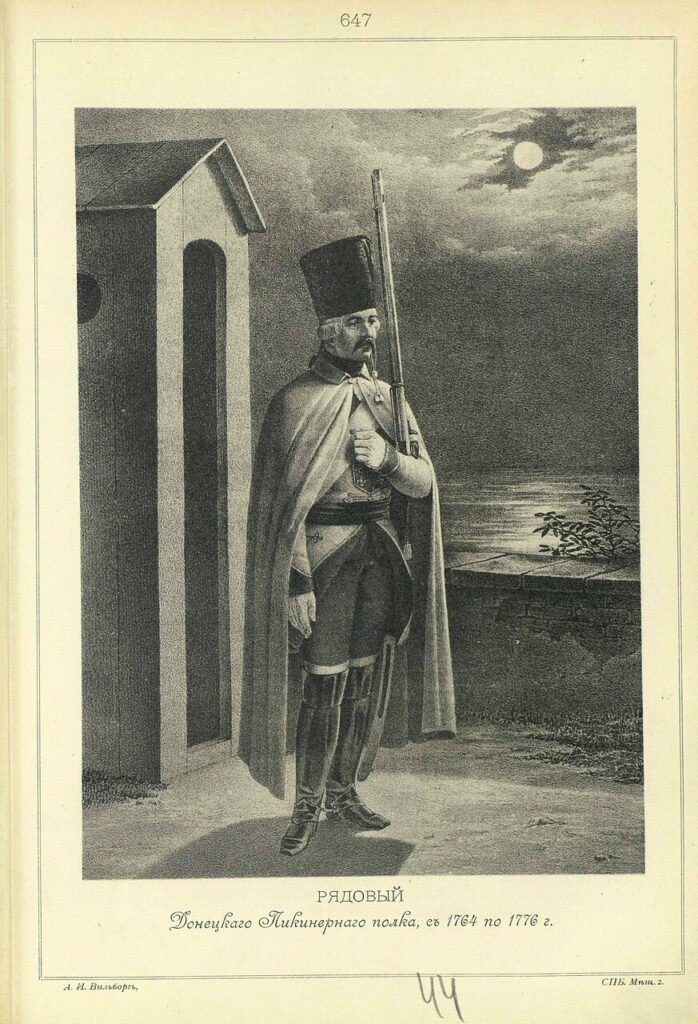
Lugansk Pike Regiment
Как уже было сказано выше полк был создан в 1764 году из расформированных сербских пандурских полков и Бахмутского конного казачьего полка, состоявших из русских, сербов, греков, македонцев, болгар, молдаван, турок и так далее, составлявших так называемых бахмутских, мояцких и торских казаков. Полк был расселен вдоль Лугани в Славяносербии. Административно Луганский полк входил в состав Бахмутской провинции Новороссийской губернии вместе с Бахмутским и Самарским гусарскими полками. При обмундировании использовали желтое сукно и черный кушак. Из знаменитых личностей в 1777 году полком командовал полковник М.И. Кутузов. Впоследствии из этого и Полтавского полка был сформирован Мариупольский легкоконный полк в шести эскадронах.
Donetsk pike regiment
Formed in 1764 and settled over the Seversky Donets. It included 5 fortresses (shants) of the former Ukrainian line: Belevskaya, Praskoveyskaya, Petrovskaya, Kozlovskaya and Ryazhenaya. It also included 5 hundred annexed from Little Russia: Nekhvoroshchanskaya, Mayatskaya, Tsarichanskaya, Kitaygorodskaya and Orelskaya. Administratively, the regiment was part of the Ekaterininsky province of the Novorossiysk province, together with the Dnieper pike regiment and the settlements of Vodolag. Bilyovskaya fortress of the Donetsk regiment was at the same time the center of the Catherine's province. The Donetsk Regiment, in particular, included the Bilevskaya, Kozlovskaya, Ryazhskaya, Nekhvoroschanskaya, Mayatskaya, Kitaygorodskaya, Tsarichanskaya, Orlitskaya, Praskoveyskaya and Petrovskaya companies.
A quarter of each company was Fusiliers on foot. The rest are mounted pikemen armed with pikes, sabers and carbines. From the literature it is known that the regiment especially distinguished itself during the capture of the Bendery fortress in 1770.
For uniforms, blue cloth and a black sash were used. On December 24, 1776, the regiment was renamed Yekaterinoslav, in 1783 the regiment was disbanded, and the personnel went to replenish the Pavlograd Light Horse Regiment.
Dnieper Pike Regiment
Created on June 9, 1764, settled along the Dnieper from the source of Samara to the border of the former New Serbia. It included 10 Little Russian hundreds of predominantly southern Poltava regiments: Starosenzharskaya, Novosenzharskaya, Belitskaya, Kobelyatskaya, Sokolskaya, Kishenskaya, Perevolochanskaya, Keleberdyanskaya, Kremenchugskaya and Vlasovskaya. Administratively, the regiment was part of the Ekaterininsky province of the Novorossiysk province, together with the Donetsk pike regiment and the settlements of Old and New Vodolagi.
The regiment was divided into 20 companies. The organization of the companies was the same as that of the Donetsk regiment. Former soldiers of the hussar regiments of Slavic Serbia also served in it. For uniforms, green cloth and a black sash were used. In 1783 the regiment was also disbanded.
Elisavetgrad Pike Regiment
Named after the fortress of St. Elisabeth (Elizabeth), founded on December 29, 1751 to protect New Serbia. Like the above regiments, this regiment was also formed in 1764, in accordance with the project for the establishment of the Novorossiysk Land Militia, to form a settled lancer regiment armed with sabers and pikes from the personnel of the Novoserbian companies - settlements (shants) of the Elisavetgrad region. It was deployed on the territory of the central part of the modern Kirovograd region and the eastern part of the modern Dnepropetrovsk region. It included 20 companies - settlements, of which 17 names are known: Murzinka, Bishkov, Ovnyansk, Kulakov, Chervonokamensk, Popelnasta, Orlinskaya, Kutsevolovka, Mishurin Rog, Dereevka, Yellow, Green, Verblyuzhka, Spasovka, Vershinokamensk, Novaya Adzhamka, Adzhamka. When wearing uniforms, he had an oblique instrument cloth and a yellow sash.
The settled regiment was disbanded in 1783, it was succeeded by the Elisavetgrad Light Horse Regiment, which became a hussar regiment in 1796 (since 1801, the Elisavetgrad Hussar Regiment).
Don Cossack Host
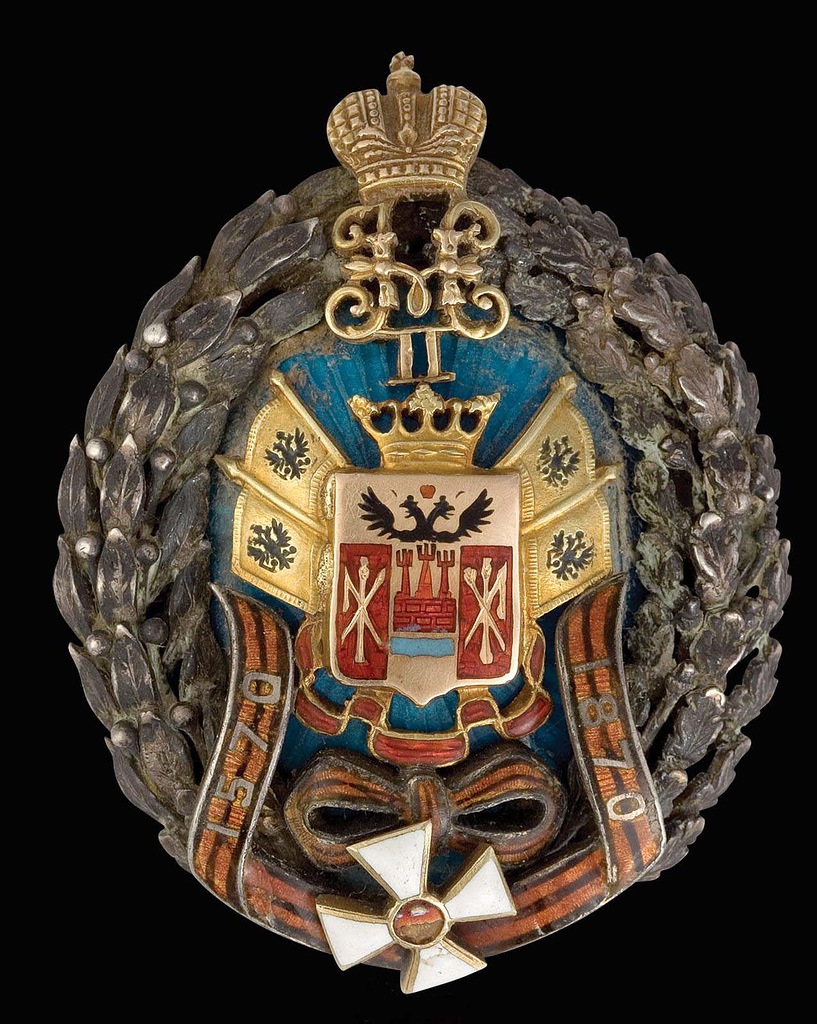
Don Cossack Host - the most numerous of the Cossack troops of the Russian Empire.
The Don Cossack army has been the first in terms of seniority in the Cossack troops since January 3, 1570, when the Don Cossacks received the first royal letter from Tsar Ivan the Terrible. Since ancient times, the Don army has been divided: Cossacks "mounted" and "grassroots". Military holiday on October 14, the Intercession of the Most Holy Theotokos. The headquarters of the Don Cossack army was located in the city of Novocherkassk.
The Don army is located on the territory called the Don Army Region, which occupied the modern Rostov and Volgograd regions, the north of the Krasnodar Territory of the Russian Federation, as well as parts of the Lugansk and Donetsk regions of Ukraine.
The historical name is associated with the Don River (basin of the Sea of Azov).
Until the beginning of the XVIII century. The Don Cossack army enjoyed wide autonomy and had self-government: the military Circle (the highest body of government and court) and elected executive bodies (ataman, 2 yesaul, clerk). During campaigns, a marching ataman with unlimited power was chosen. The army was divided into hundreds and fifty, led by centurions, Pentecostals and cornets. However, in connection with the numerous peasant troops, in many of which the Cossacks also participated, starting from 1718, an official procedure began to abolish the freedom and independence of the Cossack troops and settlements. First of all, the election of chieftains and others was abolished. In 1763, compulsory lifelong military service for the Cossacks was introduced; main occupations of the population in the XVIII century. were agriculture and horse breeding.
The Cossack regiment was the main tactical unit of the Cossack army; it was headed by a colonel, office work was conducted by the regimental headquarters. Cossack units appeared in the Russian army in 1651, when five Sloboda Cherkasy Cossack regiments were formed in Sloboda Ukraine, reorganized in 1765 into hussar and uhlan regiments. In the future, each Cossack army fielded a certain number of regiments of the 1st stage for active service; regiments of the 2nd and 3rd stage were on privileges and were called up for the duration of the war.
In the XVIII - early XIX century. It was customary to call the regiment by the name of the colonel. Later, regiment numbers appeared, enshrined in the Charter on military service of the Don Cossacks (1875), extended to other Cossack troops; the name of the Cossack army was added to the regiment number.
The armament of the Don Cossacks was the most diverse. By the end of the XVIII century. Cossack cold piercing and cutting and firearms were not of the same type, since a significant part of them were captured during wars and campaigns. The Cossacks possessed Turkish, Persian, Arabic, Hungarian, Polish, Russian and other origin cold piercing and cutting weapons and firearms. It was constantly lacking, often passed from father to son, and was a family treasure. An important role in the armament of the Cossacks was played by pikes - Russian lancers and hussars. The pike was selected "according to the hand" - by weight and length, had a forged iron tip. Neither the Polish lancers nor the armored Austrian cuirassiers could withstand the attack of the Cossacks "in darts", they suffered significant losses.
Along with the cold, the Don Cossacks were armed with firearms - mostly Caucasian guns with flintlocks and grooved flint, as well as Asian pistols.
As of March 19, 1768, 5,879 Don Cossacks were on the payroll. Of these: 2196 - in Poland; 441 - in Kizlyar; 501 - on the Siberian lines; 601 - on the Tsaritsynskaya line; 120 - at the Miussky outposts. In addition, the Cossacks were used to maintain post camps (189), to detect fugitives (380), in the garrisons of Russian cities - in Moscow, Taganrog, Borisoglebsk and Novokhopersk, especially "in Rostov to deliver letters and eradicate thieves" (152) and in the capital Cherkasy garrison (629). On April 20, 1768, a special team of Yesaul Kulikov appeared, which caught robbers on the outskirts of military lands along the Rotten and Bystraya rivers.
In total, the army included: military ataman - 1, foremen - 51, military captains - 10, marching - 2, military interpreters - 3, Cossacks - 18600. The army ataman led the army.
With the beginning of the Russian-Turkish war of 1768-1774, a significant part of the Donetsk people was sent to the First Shock Army of P. Rumyantsev, and to the Second P.I. Panin with the marching ataman Timofey Grekov (his regiment set out on January 10, 1769) sent the regiments of Ivan Gorbikov, Semyon Turoverov, Karp Kolpakov (from February 17, 1769), Efim Kuteynikov, Alexei Karshin (from November 5, 1768), Mikhail Rebrikov, Osip Loshchilin, Ivan Yanov the Lesser, Semyon Sulin, Ekim Karpov.
The regiment of Efim Kuteynikov was sent to the place of deployment of the 2nd Army before the rest. From October 14, 1768, he stood along the Samara River near the Zaporizhzhya Sich.
Even earlier, from May 15, 1768, the regiment of Semyon Turoverov stood on the Dnieper line, and from May 24, 1768, the regiment of Mikhail Rebrikov served in Tavria. The regiment of Ivan Yanov, from February 15, 1768, was stationed near Azov.
Gorbikov's regiment had been standing in Tavria since March 15, 1767. The remaining regiments were recruited in November 1768 and at the beginning of 1769.
At the same time, there was a regular rotation of units, regiments and entire Cossack formations between armies and corps, in the end, only three regiments remained in the army of Peter Panin:
- Don Cossack Army Kolchakov Regiment;
- Don Cossack Army Gorbikov Regiment;
- Don Cossack Army Grekov Regiment.
Colonel Grekov's regiment was withThe most numerous regiment in Panin's army, which consisted of more than three thousand sabers.
Little Russian (Cossack) army
Казаки Гетманщины и Запорожской Сечи, присягнувшие на верность русскому царю. Известно, что еще в 1450 г. Гетман Рожинский составил из Малороссийских казаков 10 конных полков. В 1654 г. Малороссийские Казаки, под руководством Гетмана Богдана Хмельницкого, приняли присягу на подданство Царю Алексею Михайловичу.
Малороссийское Казачье войско составляли тогда 17 полков. В 1667 г. 10 полков правой стороны Днепра отошли в подданство Польши. В составе войска остались 11 полков. В 1674 г. 10 полков правой стороны Днепра снова приведены в Русское подданство.
В 1700 – 1721 гг. эти полки участвовали в Северной войне полки из Малороссийских Казаков: Полтавский Ивана Искры, Ивана Сухия, Гадицкого, Андрея Герасимова, Пашехонского, Федковского, Лубенский, Переяславский, Данилы Перекрестова, Бехметьева и Гетманский. В 1722 г. была учреждена Особая малороссийская колегия. Повелено содержать 10 полков Малороссийских казаков: Киевский, Черниговский, Стародубовский, Нежинский, Переяславский, Прилуцкий, Лубенский, Гадячский, Миргородский и Полтавский.
В 1731 г. тысяча Малороссийских казаков переселено на Царицынскую линию и на следующий год образовало Волгское Казачье войско. К 1734 г. Малороссийское Казачье войско составляли 10 полков: Гадячский, Киевский, Лубенский, Миргородский, Нежинский, Переяславский, Полтавский, Прилуцкий, Стародубовский, Черниговский и три Охочеконных (наемных) полка. В 1741 г. было разрешено Малороссийским казакам переселятся в Оренбургские крепости. 10.11.1764 г. в Малороссии было отменено Гетманское управление. 28.06.1783 г. в связи с упразднением Малороссийского полкового устройства из Малороссийских казаков сформированы легкоконные полки регулярной армии.
Mirgorod Little Russian Regiment
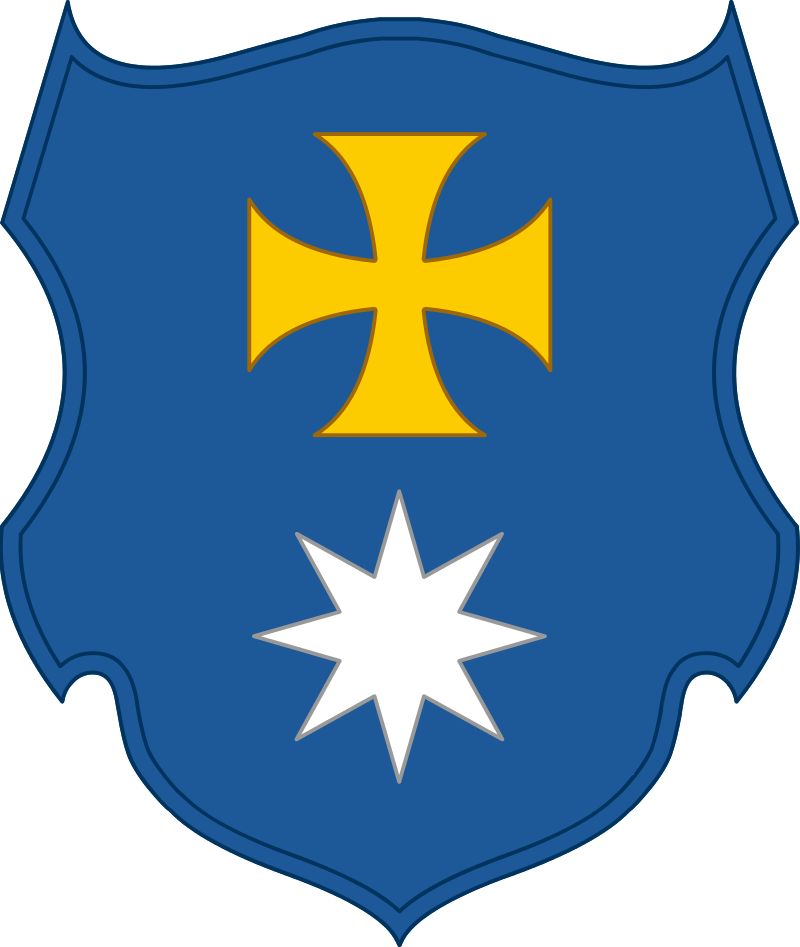
The territory of the Mirgorod regiment (territory) began to be settled in the first quarter of the 17th century, and already in 1625 a Cossack regiment was formed with a regimental center in Lubny. The regiment was supposed to protect the possessions of the family of the Vishnevetsky princes in the Left-Bank Ukraine from the Crimean raids. In 1638, the regiment was disbanded, and hundreds were included in the Chigirinsky and Pereyaslavsky regiments. At the beginning of the Khmelnytsky uprising in 1648, the regiment was restored by the rebellious Cossacks. On October 16, 1649, after the Treaty of Zboriv, the regiment received official status in the Commonwealth. According to the register of 1649, there were 16 hundreds in the regiment. In 1654, after the Pereyaslav Rada, according to the sworn lists, 4792 people swore allegiance to the regiment.
In 1723, the regiment had 15 hundreds, which consisted of 454 foot and 4386 horse Cossacks. In 1782, the Mirgorod regiment was disbanded, and its territories became part of the Kyiv governorship. In 1770, the regiment was commanded by Colonel Alexander Bezborodko.
Gadyachsky (Galitsky) Little Russian regiment
The Hadyatsky (Gadyachsky) Regiment is a military-administrative unit of the Hetmanate with its capital in Gadyach. The regiment was founded in 1648, disbanded several times and finally abolished in 1782.
Сформированный в 1648 году, Гадячский полк уже в 1649 году по Зборовскому договору был расформирован, сотни полка были переданы Полтавскому полку, а на территории полка создано Гадячское староство в собственности гетмана Войска Запорожского.
- В 1658 году полк был восстановлен, но находился в подчинении миргородских полковников.
- In 1660, the Gadyach eldership was liquidated, and its territory was divided between the Mirgorod and Zenkovsky regiments.
- In 1672, the regimental center of the Zenkovsky regiment was moved to Gadyach and the former name was returned to the regiment.
По ревизии 1764 года в полку состояли: 21 сотня, 11 городов, 982 сел и хуторов. В полку было 21 986 выборных казаков. На 1770 год командиром полка был полковник Антон Кржижановский и наказным полковников (Врио командира) полковник Андрей Горленко.
Starodubovsky (Starodubsky) Little Russian Regiment
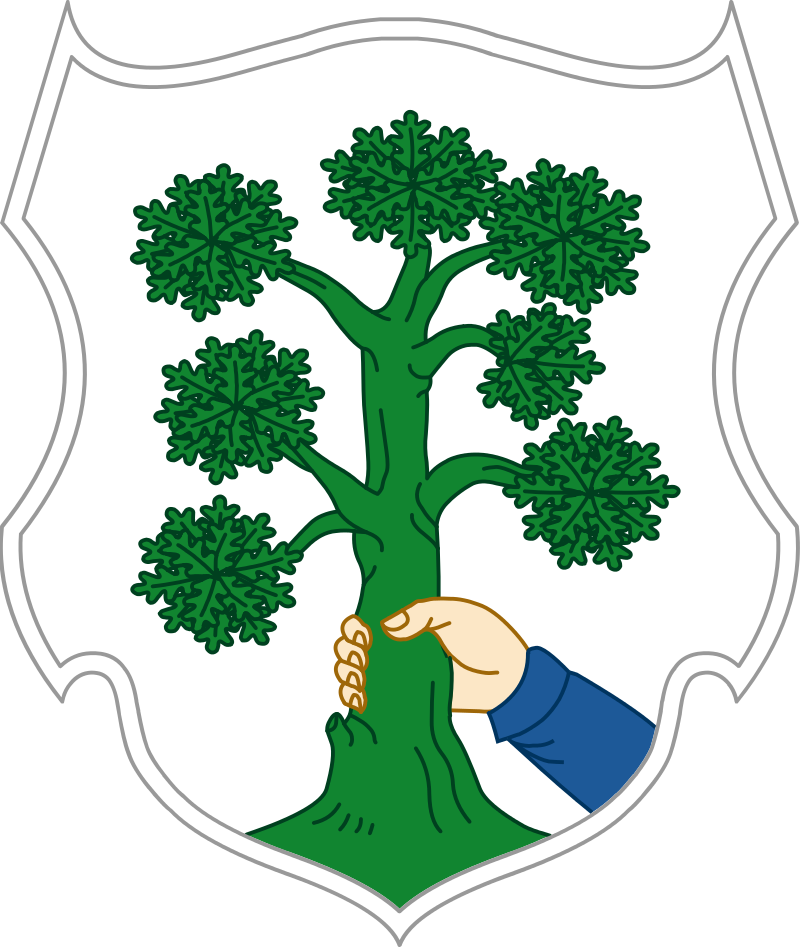
Административно-территориальная и войсковая единица Гетманщины, существовавшая с середины XVII века до 1781 года.
Regimental city - Starodub (now the regional center of the Bryansk region). The Starodubsky regiment was the most extensive of all ten regiments of Little Russia. It included the districts of two ancient centers of the Seversk land - Starodub and Novgorod-Seversky, each of which during the period of feudal fragmentation was the center of an independent principality. After the formation of the Russian and Lithuanian states, the Seversk land, located on their borders, drew upon itself the claim of both states.
Initially, the Starodubsky regiment consisted of 10 hundreds (regimental Starodubskaya, Novgorod-Severskaya, Sheptakovskaya, Pogarskaya, Pochepskaya, Mglinskaya, Drokovskaya, Popovogorskaya, Bobovitskaya and Topalskaya), later the hundredth division changed.
In 1763, two judicial districts were created on the territory of the regiment - Starodubsky and Pogarsky, and in 1766 three commissariats - Starodubsky, Topalsky and Novgorod-Seversky. According to the revision of 1764, the regiment had 12 hundreds, 7050 elected Cossacks, 18107 assistants and 147629 Commonwealth.
By the time the regiment was disbanded (1781), it included the following hundreds: two regimental Starodubsky, two Pochepsky, Novomestskaya, Topalskaya, Mglinskaya, Baklanskaya, Pogarskaya, Novgorodskaya (Novgorod-Severskaya) and Sheptakovskaya. At that moment, there were 4 cities, 3 towns and 1118 other settlements on the territory of the Starodub regiment.
In 1770, the regiment was temporarily commanded by Colonel Mikhailo Miklashevsky.
Chernihiv Little Russian Regiment
Территориально-военно-административная единица Войска Запорожского со столицей в Чернигове, созданная в 1648 году. Упразднён в 1781 году. Черниговский полк был основан весной 1648 года в ходе восстания Хмельницкого. Юридически территория и состав Черниговского полка были оформлены 16 октября 1649 года по Зборовскому реестру. В состав полка входили 997 казаков в 8 сотнях. По Зборовскому реестру в состав полка вошли территории упраздненных Борзнянского и Сосницкого полков. После Переяславской рады 1654 года значительное число сотен полка было переведено в Нежинский полк. С 1659 года в полку стали образовываться новые сотни и к 1672 году полк насчитывал 16 сотен. По ревизии 1764 года в полку было 9 838 выборных казаков, 19 810 помощников и 101 556 душ прочего населения в 18 сотнях. Полк был упразднен указом императрицы Екатерины II от 27 сентября 1781 года, а его территории вошли в состав Черниговского наместничества. На 1770 год полком командовал полковник Петр Милорадович.
Lubensky Little Russian Regiment
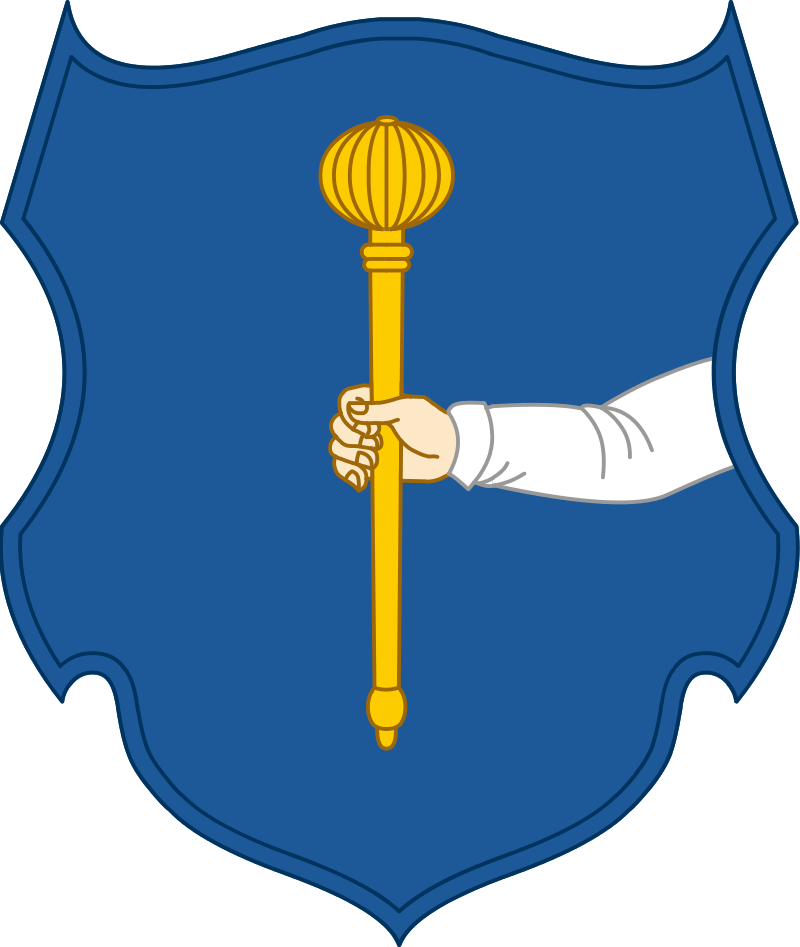
Administrative-territorial and military unit of the Hetmanate in the XVII-XVIII centuries, one of the 10 administrative-territorial Cossack regiments of the Hetmanate. The regimental center is the city of Lubny. The regiment was created in 1648. After the Zborovsky treaty of 1649, he was attached to the Mirgorod regiment. Rebuilt in 1658. The number of hundreds in a regiment varied from 13 in 1658 to 23 in the 18th century. In 1658, it included 7 hundreds of Mirgorodsky, 4 hundreds of Kropivnyansky and 2 hundreds of Poltava regiments.
According to the list of 1723, the regiment had 2687 foot and 3968 horse Cossacks.
As of 1781, the regiment included 23 hundreds: two regimental Lubensky, two Pyryatinsky, two Lokhvitsky, two Senchansky, Chernousskaya, Yangshipolskaya, Glinskaya, Romenskaya, Khmelevskaya, Smelyanskaya, Konstantinovskaya, Kurinskaya, Gorodiskaya, Snitinskaya, Lukomskaya, Goroshinskaya, Zhovninskaya, Chigirin-Dubrovskaya, Yablunivskaya. At that time, 21 towns and 1609 villages were located on the territory of the regiment. In connection with the liquidation of the regimental system in Ukraine in 1781, it ceased to exist. Its territory became part of the Kyiv and Chernigov governorships.
Nezhinsky Little Russian Regiment
The Nizhyn Regiment is an administrative and military unit of the City Host of the Zaporizhzhya Poland (registered) and the Zaporizhzhya Host (Hetmanate) of Russia, with the regiment's capital in the city of Nizhyn since 1649.
Other major cities of the Cherkasy regiment included Priluki, Glukhov and Baturyn. The last two at different times were the capitals of the Zaporizhzhya army (Hetmanate).
The Nezhinsky regiment was founded in 1648, in 1653 it expanded due to the addition of the neighboring Novgorod-Seversky regiment to it. During this period of time, the regiment consisted of ten hundred Cherkasy.
At the numerous requests of the Cossacks, in Moscow, it was decided by the Zemsky Sobor, on October 1, 1653, to accept the Zaporizhzhya Army with all the regiments into the citizenship of the Russian Tsar. In 1663, the newly formed Starodubsky regiment separated from the Nezhinsky regiment.
In Little Russia, with the judicial reform of 1763, the settled regiments were divided into povets (districts) according to court cases. The Nezhinsky regiment was divided into three districts. In each povet, a zemstvo court (povet zemstvo court) was established, located in the povet city.
In 1782, according to the decree of Catherine II, the regiment, as an administrative unit, was disbanded and included in the Chernihiv governorship. And from hundreds of regiments on June 28, 1783, the Nezhinsky cavalry regiment of the Little Russian cavalry was formed.
Companion Little Russian Regiment
"Okhotnitsky" (sociable and Serdyutsky) Cossack regiments existed in Little Russia in the 17th-18th centuries. The official date of formation of the company regiments is August 30, 1668. People from the Severu region (“sevryuks”), Poles, Moldavians and Serbs mainly went to serve in the companion regiments. The original purpose of the companions was only to carry out police duties, they also began to be used in the suppression of popular unrest. The companions often exceeded their power, carrying out riots and even murders, about which petitions regularly wrote to the Russian Tsar. These regiments were recruited by the hetman himself from “eager people” (mercenaries), did not have a specific territory, were named after the names of the colonels and were maintained at the expense of the combined arms, and then the state treasury.
In addition to the sociable regiments, Seryut regiments also appeared in Little Russia. Serdyuks (from Turkish sürtük "guide, spy", or angry, evil). The Serdyutsky infantry regiments were also maintained at the expense of the hetman's treasury and were the hetman's personal security guard.
Under Hetman Mazepa, by 1709 the number of such regiments had grown to 10 - 5 companions and 5 Serdyuts. There was also a regiment of the hetman's personal guard - "the company of the court banners." It was Mazepa who began to use these regiments as military ones.
Before Poltava, most of the regiments betrayed Peter I, went to the Swedes along with Mazepa. Three companion regiments of colonels Chugin, Kolbaev and Khvedkov, as well as one Serdyutsky regiment of Burlyaev, remained loyal to him. In 1726, the Serdyutsky regiment was abolished, and in 1746 the remaining company regiments received numbers from 1 to 3.
According to the painting of the Russian army on May 30, 1756, three companionable, Little Russian regiments are mentioned as part of the cavalry: Chernigov, Kiev, Novgorod-Seversky.
For the first time they took part in hostilities in the Seven Years' War, being under the unified command of Karp Garlic. All military leaders admitted that the companion regiments were much better prepared than ordinary Cossack ones.
In Panin's army, the regiment is represented by only one battalion. In the Order for the troops, the regiment is named second, i.e. Regiment Kolbaeva (Kyiv). Transferred under the command of Colonel Serebryakov.
In 1776, all three companion regiments were converted into light-horse regular regiments, and in 1785 into carabinieri.
Kalmyk army
By the beginning of the 18th century, Kalmyk settlements appeared outside the Kalmyk Khanate. These are Donskoye, Chuguevskoye, Stavropolskoye, Orenburgskoye, Yaikskoye. In the second half of the 18th century, they also arose on the Terek and the Dnieper. The Cossacks, knowing the Kalmyks as "... good horsemen, excellent in courage, always ready and zealous for service," tried to attract them into their class. It was the Don Kalmyks, who arrived in the army together with the Don Cossacks, who were present in the army of Peter Panin.
Kalmyk settlements on the Don arose in the second half of the 17th century. and grew throughout the eighteenth century. due to the influx of Kalmyk groups. The Kalmyk nobility constantly turned to the Russian government with requests to ban the Kalmyks from settling on the Don, but this did not stop the influx of Kalmyks to the Don.
Don Kalmyks, included in the Cossack Don Army, continued to engage in their traditional activity - cattle breeding.
From the second half of the XVIII century. a small part of the Don Kalmyks began to engage in agriculture. The life of the Don Kalmyks until the 19th century. traditionally built according to national laws.
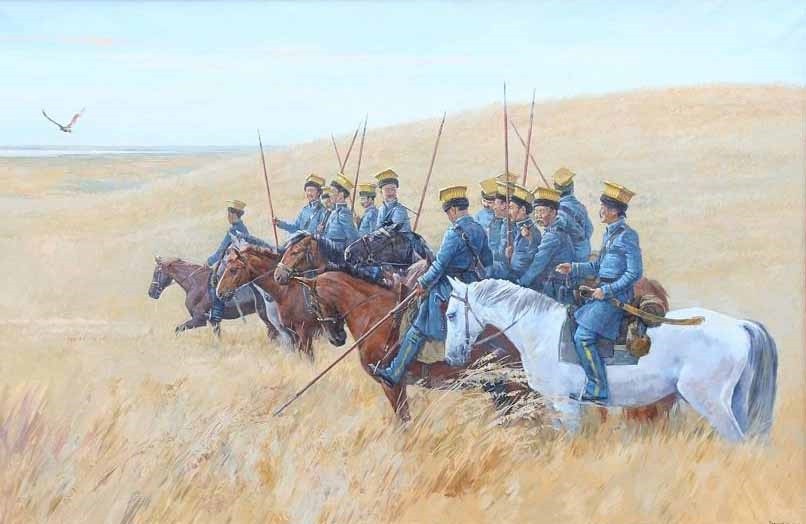
From the middle of the XVIII century. the Don administration divided its wards into three uluses and several hundred, while the leader of the ulus was called the ataman, and the centurion was called the centurion. The Don Kalmyks, depending on the combined arms mobilization, were obliged to complete individual hundreds led by their owners (atamans) and replenish the composition of the Cossack regiments.
Kalmyks appeared within Russia at the beginning of the 17th century. They migrated from the Dzungar Khanate and formed the Kalmyk Khanate in the lower reaches of the Volga River, which was strengthened under Ayuka Khan. Archival documents testify that the Kalmyks were called to the Don by local Cossacks to jointly fight the Crimean Tatars.
So, in 1642, the Don Cossacks turned to their new neighbors with a proposal to jointly fight the Crimeans for the mastery of Azov. And in 1648, the Kalmyks first appeared near the Cherkasy town. A defensive and offensive alliance was concluded between the Kalmyks and the Cossacks, according to which 1000 Kalmyks opposed the Crimeans. Since that time, treaties were concluded between them and oaths were taken about the faithful service of Russia.
In 1696, Ayuka Khan released up to three thousand wagons (about ten thousand people) to the Don near Azov to guard the border line and fight the Azov people. These Kalmyks did not return to the Kalmyk Khanate, they remained on the Don, near Cherkassk. Some of them adopted the Orthodox faith.
In 1710, Ayuka Khan sent an additional ten thousand Kalmyks to the Don, led by the Torgout owner Chimet and the Derbet owner Chetyrem to carry out security service of the southern borders from the raids of the Kuban.
In 1723, Peter I ordered all the Kalmyks roaming the Don to be left in the Cossack estate and no more representatives of this nationality be accepted to these lands. Thus, in 1731, the Kalmyks, who crossed over to the Don, became part of the population of the Don Cossacks and were subordinate to the Administration of the Military Cossacks. In 1745, the entire inhabited Western steppe was given over to the nomadic Kalmyks, who were assigned to the Don Army. Three Kalmyk uluses with farms and population were formed on these lands: Upper, Middle and Lower.
Sources and literature:
- REPORT on the state of the second army, in which it joined the company and settled in winter quarters to fence off the borders entrusted to custody from the enemy for December 1769. F. VUA f / t No. 1853-1 (2) l. 128-129
- ПРИКАЗ генералитету и полкам 2 ой Армии под предводительством генерала графа Панина, сочиненное им на компанию 1770-го года, а изданное при лагере в Елисаветградской провинции у реки Виси (Выси) мая 24 (21) дня. //РГВИА ВУА Фонд 846 опись 16 дело 1853 -2 (1) стр.102//
- K. V. Tatarnikov Service and viewing lists of the Russian army of 1730 - 1796 in the collection of the Russian State Historical Archives, three volumes
- Complete collection of laws of the Russian Empire. SPb., 1830 (PSZRI)
- Рабинович М.Д. Полки петровской армии. 1698-1725. М., 1977
- Висковатов А. В. Историческое описание одежды и вооружения российских войск, с рисунками, составленное по Высочайшему повелению: в 30 т.: в 60 кн. — Факсимильное издание 1841–1862 гг. — СПб.: Альфарет, 2007–2008 гг.
- “Воинской календарь на 1766 годъ съ приложенiемъ Генералитетскихъ и Штабскихъ списковъ” СПб, 1767 г.
- S.D. Okhlyabin. Daily life of the Russian army during the Suvorov wars. Moscow, 2004
- Urusov S.P. History of the 4th Life Dragoon Pskov Her Majesty's Regiment. 1701-1883 2nd ed., St. Petersburg, 1886
- Shenk V.K., Modzalevsky N.K. Cavalry. Reference book of the Imperial Main Apartment, St. Petersburg, 1914.
- Шенк В.К. “Кавалерия” изд. 2-е СПб., 1909 г.
- Гукова Е. А. Украинская линия и украинский ландмилицкий корпус в трудах военных историков // Электронный журнал «Знание. Понимание. Умение». — 2009. — № 5 – История.
- Звегинцев В.В.Русская армия. Ч. I. 1700—1763 гг. — Париж, 1973.
- Zubarev F.I. Memo of the 12th Astrakhan Grenadier ... Regiment. 1800-1910. M., 1910.
- Reference books of the Imperial Headquarters, edited by V.K. Shenk. SPb., 1909, SPb., 1912
- Урбан И. Э. Краткая история 6-го гренадерского Таврического полка. — Тула: тип. Губ. правл., 1890. — 80 с., 9 л. ил.
- Будницкий. Кратая история 139-го пехотного Моршанского полка, Рязань, 1894
- Огарков Н. В. Черниговский полк // Советская Военная Энциклопедия. — М.: Воениздат. — Т. 8. — С. 454. — 687 с.
- Военная энциклопедия в 18 т., под ред.В.Ф, Новицкого и др. — СПб. ; [М.] : Тип. т-ва Сытина, 1911—1915.
- RGIA, F.806, op.7, d.142 1893 Gazette of the Church of the Holy Trinity of the Yelets Regiment.
- RGVIA F.490.1.13a
- D.L. Tsybakov. Orlovsky regiment in the military campaigns of the XVIII century. Website project "Eagle in Russian", http://eagleporuss.rf/2014/10/21/orlovskij-polk-v-voennyh-kampaniyah-xviii-stoletiya/
- L.V. Dimperan. 70th Ryazhsky Infantry Regiment. Article. Electronic resource of the unofficial site of Ryazhsk, https://62info.ru/history/node/2042
- Слюнченко, Ю. И. Верою незыблемы к России. Предыстория и боевой путь 34-го пехотного Севского генерала графа Каменского полка : [историко-краеведческий очерк], Брянск, 2009
- RGVIA, F490.1.578
- Керсновский А. А. История русской Армии. Т. 2. М., 1993
- Chronicle of the Russian Imperial Army, compiled by the highest command. Ch. I-VII. SPb., 1852
- Иррегулярные войска // Большая советская энциклопедия : [в 30 т.] / гл. ред. А. М. Прохоров. — 3-е изд. — М. : Советская энциклопедия, 1969—1978.
- Brief essay on the History of the 3rd Sumy Dragoon Regiment, compiled by Lieutenant P.P. Golodolinsky. Moscow, 1890.
- Гербель Н. Изюмский Слободской казачий полк 1651—1765 гг. — Санкт-Петербург, 1852.
- Изюмский 33-й драгунский полк // Энциклопедический словарь Брокгауза и Ефрона : в 86 т. (82 т. и 4 доп.). — СПб., 1890—1907.
- Сайт Ахтырские гусары. Военно-исторический клуб. Часть II. Полки Российской регулярной кавалерии 1698 – 1917 гг. Жёлтый и Черный гусарские полки (2). http://www.gusa.ru/pasha3.html
- Краткая хроника казачьих войск и войск, бывших на положении казачьих // Казачьи войска (Хроники гвардейских казачьих частей помещённые в книге Императорской гвардии) / Под редакций В. К. Шенка. — Справочная книжка Императорской Главной квартиры, 1912 (репринтное издание АО «Дорваль», 1992).
- Ivanov P. A. Review of the composition and organization of the regular Russian cavalry from Peter the Great to the present day. SPb. 1864
- Кабузан В. М. Заселение Новороссии (Екатеринославской и Херсонской губерний) в XVIII — первой половине XIX века (1719—1858 гг.). / Институт истории СССР АН СССР. — М.: Наука, 1976. — 306 с.
- Путешествие И. А. Гильденштедта по Елисаветградской провинции (1774 г.) // Елисаветградский вестник. — 1889.
- Астапенко М. П. Донские казаки 1550—1920. — Ростов н/Д: Логос, 1992.
- Андрей Венков. Казаки в Первой русско-турецкой войне. 1768–1774 гг., Изд. «Вече», электронная версия Ю. Галушко. Казачьи войска России. М. 1993. ИАА “Русский мир”
- Заруба В. М. Адміністративно-територіальний устрій та адміністрація Війська Запорозького у 1648-1782 рр. — Дніпропетровськ: Ліра ЛТД, 2007
- А. М. Лазаревский. Описание старой Малороссии. Том I. Полк Стародубский. — Киев, 1888.
- Small Dictionary of the History of Ukraine / Managing editor Valery Smoly. - K .: Libid, 1997
- Калмыцкое войско // Военная энциклопедия : [в 18 т.] / под ред. В. Ф. Новицкого … [и др.]. — СПб. ; [М.] : Тип. т-ва И. Д. Сытина, 1911—1915.